|
PLearn 0.1
|
|
PLearn 0.1
|
Base class for PLearn probability distributions. More...
#include <PDistribution.h>
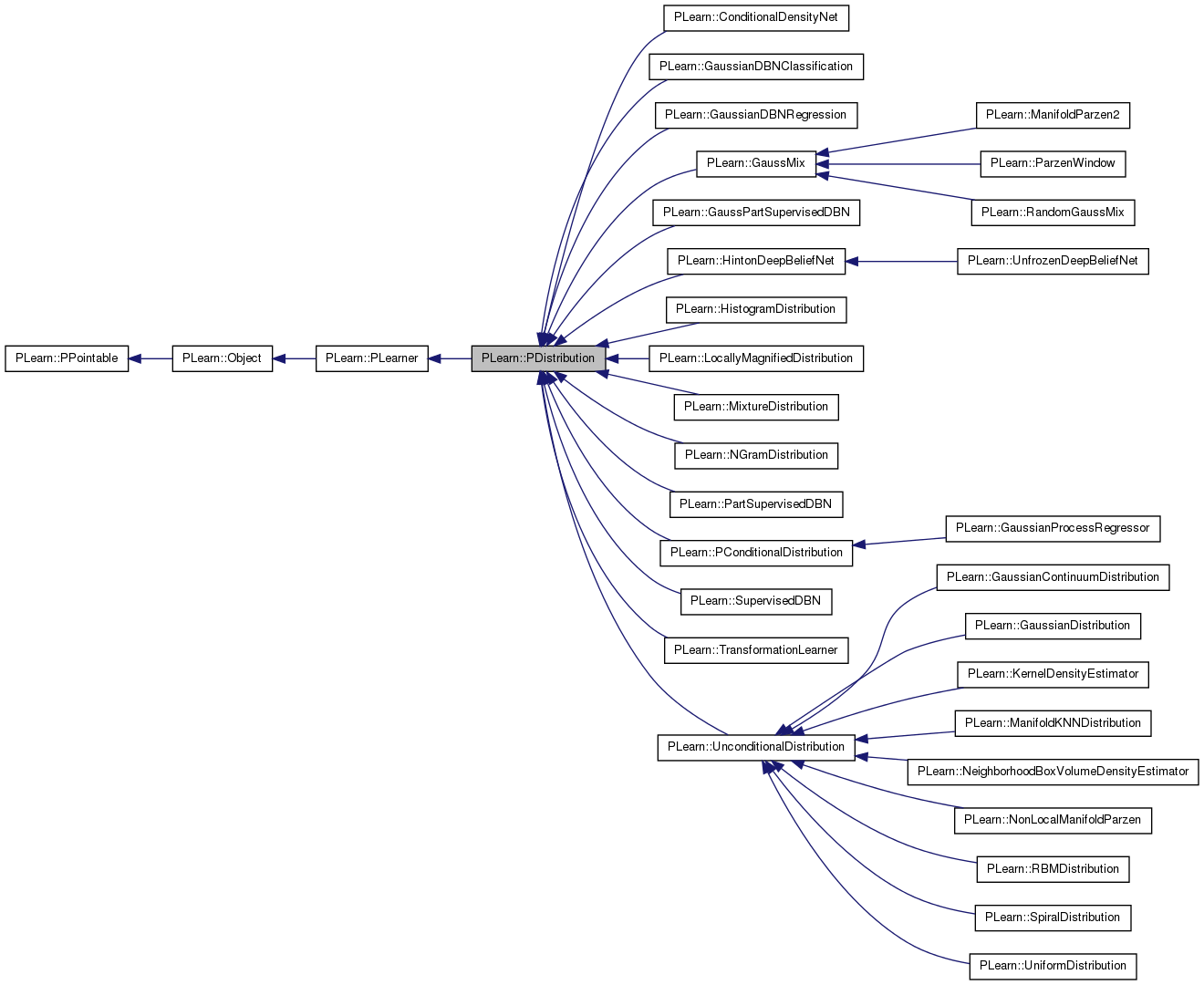
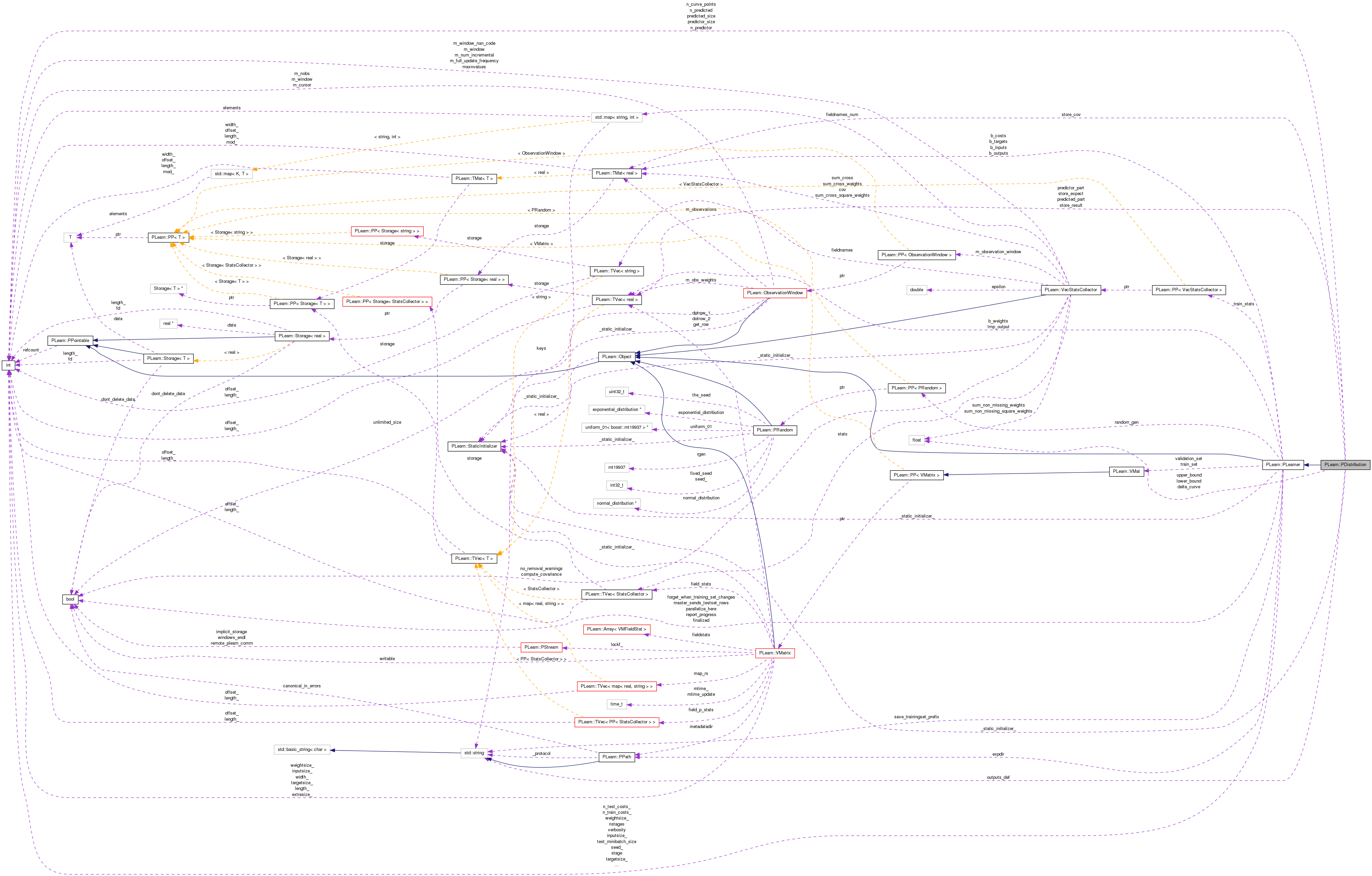
Public Member Functions | |
| PDistribution () | |
| Default constructor. | |
| virtual void | build () |
| Simply calls inherited::build() then build_(). | |
| virtual void | makeDeepCopyFromShallowCopy (CopiesMap &copies) |
| Transforms a shallow copy into a deep copy. | |
| virtual string | classname () const |
| virtual OptionList & | getOptionList () const |
| virtual OptionMap & | getOptionMap () const |
| virtual RemoteMethodMap & | getRemoteMethodMap () const |
| virtual PDistribution * | deepCopy (CopiesMap &copies) const |
| virtual int | outputsize () const |
| Returned value depends on outputs_def. | |
| virtual void | forget () |
| (Re-)initializes the PLearner in its fresh state (that state may depend on the 'seed' option) And sets 'stage' back to 0 (this is the stage of a fresh learner!) | |
| virtual void | train () |
| The role of the train method is to bring the learner up to stage==nstages, updating the train_stats collector with training costs measured on-line in the process. | |
| virtual void | computeOutput (const Vec &input, Vec &output) const |
| Produce outputs according to what is specified in outputs_def. | |
| virtual void | computeCostsFromOutputs (const Vec &input, const Vec &output, const Vec &target, Vec &costs) const |
| Computes negative log likelihood (NLL). | |
| virtual bool | setPredictorPredictedSizes (int the_predictor_size, int the_predicted_size, bool call_parent=true) |
| Set the 'predictor' and 'predicted' sizes for this distribution. | |
| virtual void | setPredictor (const Vec &predictor, bool call_parent=true) const |
| Set the value for the predictor part of a conditional probability. | |
| virtual TVec< string > | getTestCostNames () const |
| Return [ "NLL" ] (the only cost computed by a PDistribution). | |
| virtual TVec< string > | getTrainCostNames () const |
| Return [ ]. | |
| virtual real | log_density (const Vec &y) const |
| Return log of probability density log(p(y | x)). | |
| virtual real | density (const Vec &y) const |
| Return probability density p(y | x) (default version simply returns exp(log_density(y))). | |
| virtual real | survival_fn (const Vec &y) const |
| Return survival function: P(Y>y | x). | |
| virtual real | cdf (const Vec &y) const |
| Return cdf: P(Y<y | x). | |
| virtual void | expectation (Vec &mu) const |
| Return E[Y | x]. | |
| virtual void | missingExpectation (const Vec &input, Vec &mu) |
| Return E[Y | x] where Y is the missing part in the 'input' vector, and x in the observed part (thus discarding any current setting of predictor and predicted sizes). | |
| virtual void | variance (Mat &cov) const |
| Return Var[Y | x]. | |
| virtual void | resetGenerator (long g_seed) |
| Reset the random number generator used by generate() using the given seed. | |
| virtual void | generate (Vec &y) const |
| Return a pseudo-random sample generated from the conditional distribution, of density p(y | x). | |
| Vec | remote_generate () |
| Remote interface for 'generate'. | |
| virtual void | generateN (const Mat &Y) const |
| X must be a N x n_predicted matrix. | |
| virtual void | generateJoint (Vec &xy) |
| Generates a pseudo-random sample (x,y) from the JOINT distribution, of density p(x, y) i.e., generates a predictor and a predicted part, regardless of any previously set predictor. | |
| void | generateJoint (Vec &x, Vec &y) |
| Generates a pseudo-random sample (x,y) from the JOINT distribution, of density p(x, y), split in two vectors i.e., generates a predictor and a predicted part, regardless of any previously set predictor. | |
| virtual void | generatePredictor (Vec &x) |
| Generates a pseudo-random sample x from the marginal distribution of predictors, of density p(x), i.e., generates a predictor part, regardless of any previously set predictor. | |
| virtual void | generatePredicted (Vec &y) |
| Generates a pseudo-random sample y from the marginal distribution of predicted parts, of density p(y) (and NOT p(y | x)). | |
| virtual void | generatePredictorGivenPredicted (Vec &x, const Vec &y) |
| Generates a pseudo-random sample x from the reversed conditional distribution, of density p(x | y) (and NOT p(y | x)). | |
| int | getNPredicted () const |
| 'Get' accessor for n_predicted. | |
| int | getNPredictor () const |
| 'Get' accessor for n_predictor. | |
Static Public Member Functions | |
| static string | _classname_ () |
| static OptionList & | _getOptionList_ () |
| static RemoteMethodMap & | _getRemoteMethodMap_ () |
| static Object * | _new_instance_for_typemap_ () |
| static bool | _isa_ (const Object *o) |
| static void | _static_initialize_ () |
| static const PPath & | declaringFile () |
Public Attributes | |
| real | lower_bound |
| real | upper_bound |
| int | n_curve_points |
| string | outputs_def |
Static Public Attributes | |
| static StaticInitializer | _static_initializer_ |
Protected Member Functions | |
| void | splitCond (const Vec &input) const |
| Split an input into the part corresponding to the predictor (in 'predictor_part'), and the predicted (in 'predicted_part'). | |
| virtual void | unknownOutput (char def, const Vec &input, Vec &output, int &k) const |
| Called in computeOutput when an unknown character is found. | |
Static Protected Member Functions | |
| static void | declareOptions (OptionList &ol) |
| Declares this class' options. | |
| static void | declareMethods (RemoteMethodMap &rmm) |
| Declare the methods that are remote-callable. | |
Protected Attributes | |
| Vec | store_expect |
| Global storage to save memory allocations. | |
| Vec | store_result |
| Mat | store_cov |
| real | delta_curve |
| The step when plotting the curve (upper case outputs_def). | |
| Vec | predictor_part |
| Used to store the x part in p(y|x). | |
| Vec | predicted_part |
| Used to store the y part in p(y|x). | |
| int | predictor_size |
| User-provided sizes of the 'predictor' and 'predicted' sizes. | |
| int | predicted_size |
| int | n_predictor |
| Learnt sizes of the 'predictor' and 'predicted' sizes. | |
| int | n_predicted |
Private Types | |
| typedef PLearner | inherited |
Private Member Functions | |
| void | build_ () |
| This does the actual building. | |
Base class for PLearn probability distributions.
PDistributions derive from PLearner, as some of them may be fitted to data by training, but they have additional methods allowing e.g. to compute density or generate data points.
By default, a PDistribution may be conditional to a predictor part x, in order to represent the conditional distribution of P(Y | X = x). An unconditional distribution should derive from UnconditionalDistribution as it has a simpler interface.
Since we want to be able to compute for instance P(Y = y | X = x), both the predictor part 'x' and the predicted part 'y' must be considered as input from the PLearner framework point of view. Thus one must specify the size of the predictor part by the 'predictor_size' option, and the size of the predicted by the 'predicted_size' option, satisfying the following equality:
predictor_size + predicted_size == inputsize (1)
Optionally, 'predictor_size' or 'predicted_size' (but not both) may be set to -1, and the PDistribution will automatically guess the other size so that equation (1) is satisfied (actually, in order to preserve the user-provided values of 'predictor_size' and 'predicted_size', the guessed values are stored in the learnt options 'n_predictor' and 'n_predicted'). This way, unconditional distributions can be created by setting 'predictor_size' to 0 and 'predicted_size' to -1.
The default implementations of the learner-type methods for computing outputs and costs work as follows:
For conditional distributions, the input must always be made of both the 'predictor' part (x) and the 'predicted' part (y), even if the output may not need the predicted part (e.g. to compute E[Y | X = x]). The exception is when computeOutput(..) needs to be called successively with the same value of 'x': in this case, after a first call with both 'x' and 'y', one may only provide 'y' as input in later calls, and 'x' will be assumed to be unchanged. Or, alternatively, one can set the 'predictor_part' option first, either through the options system or using the setPredictor(..) method.
IMPLEMENTATION NOTES: Note that many methods are declared as 'const' because of the 'const' plague, but are actually not true 'const' methods. This is also why a lot of stuff is mutable. TODO: Would it be possible to remove some 'const' stuff for cleaner code?
Definition at line 99 of file PDistribution.h.
typedef PLearner PLearn::PDistribution::inherited [private] |
Reimplemented from PLearn::PLearner.
Reimplemented in PLearn::ConditionalDensityNet, PLearn::GaussianContinuumDistribution, PLearn::GaussianProcessRegressor, PLearn::PConditionalDistribution, PLearn::LocallyMagnifiedDistribution, PLearn::NeighborhoodBoxVolumeDensityEstimator, PLearn::TransformationLearner, PLearn::GaussianDistribution, PLearn::GaussMix, PLearn::HistogramDistribution, PLearn::KernelDensityEstimator, PLearn::ManifoldParzen2, PLearn::MixtureDistribution, PLearn::NGramDistribution, PLearn::NonLocalManifoldParzen, PLearn::ParzenWindow, PLearn::RandomGaussMix, PLearn::RBMDistribution, PLearn::SpiralDistribution, PLearn::UnconditionalDistribution, PLearn::UniformDistribution, PLearn::GaussianDBNClassification, PLearn::GaussianDBNRegression, PLearn::GaussPartSupervisedDBN, PLearn::HintonDeepBeliefNet, PLearn::PartSupervisedDBN, PLearn::SupervisedDBN, PLearn::UnfrozenDeepBeliefNet, PLearn::GaussianProcessRegressor, and PLearn::ManifoldKNNDistribution.
Definition at line 104 of file PDistribution.h.
| PLearn::PDistribution::PDistribution | ( | ) |
Default constructor.
Definition at line 53 of file PDistribution.cc.
References PLearn::PLearner::random_gen.
:
delta_curve(0.1),
predictor_size(0),
predicted_size(-1),
n_predictor(-1),
n_predicted(-1),
lower_bound(0.),
upper_bound(0.),
n_curve_points(-1),
outputs_def("l")
{
random_gen = new PRandom();
}
| string PLearn::PDistribution::_classname_ | ( | ) | [static] |
Reimplemented from PLearn::PLearner.
Reimplemented in PLearn::ConditionalDensityNet, PLearn::GaussianContinuumDistribution, PLearn::GaussianProcessRegressor, PLearn::PConditionalDistribution, PLearn::LocallyMagnifiedDistribution, PLearn::NeighborhoodBoxVolumeDensityEstimator, PLearn::TransformationLearner, PLearn::GaussianDistribution, PLearn::GaussMix, PLearn::HistogramDistribution, PLearn::KernelDensityEstimator, PLearn::ManifoldParzen2, PLearn::MixtureDistribution, PLearn::NGramDistribution, PLearn::NonLocalManifoldParzen, PLearn::ParzenWindow, PLearn::RandomGaussMix, PLearn::RBMDistribution, PLearn::SpiralDistribution, PLearn::UnconditionalDistribution, PLearn::UniformDistribution, PLearn::GaussianDBNClassification, PLearn::GaussianDBNRegression, PLearn::GaussPartSupervisedDBN, PLearn::HintonDeepBeliefNet, PLearn::PartSupervisedDBN, PLearn::SupervisedDBN, PLearn::UnfrozenDeepBeliefNet, PLearn::GaussianProcessRegressor, and PLearn::ManifoldKNNDistribution.
Definition at line 110 of file PDistribution.cc.
| OptionList & PLearn::PDistribution::_getOptionList_ | ( | ) | [static] |
Reimplemented from PLearn::PLearner.
Reimplemented in PLearn::ConditionalDensityNet, PLearn::GaussianContinuumDistribution, PLearn::GaussianProcessRegressor, PLearn::PConditionalDistribution, PLearn::LocallyMagnifiedDistribution, PLearn::NeighborhoodBoxVolumeDensityEstimator, PLearn::TransformationLearner, PLearn::GaussianDistribution, PLearn::GaussMix, PLearn::HistogramDistribution, PLearn::KernelDensityEstimator, PLearn::ManifoldParzen2, PLearn::MixtureDistribution, PLearn::NGramDistribution, PLearn::NonLocalManifoldParzen, PLearn::ParzenWindow, PLearn::RandomGaussMix, PLearn::RBMDistribution, PLearn::SpiralDistribution, PLearn::UnconditionalDistribution, PLearn::UniformDistribution, PLearn::GaussianDBNClassification, PLearn::GaussianDBNRegression, PLearn::GaussPartSupervisedDBN, PLearn::HintonDeepBeliefNet, PLearn::PartSupervisedDBN, PLearn::SupervisedDBN, PLearn::UnfrozenDeepBeliefNet, PLearn::GaussianProcessRegressor, and PLearn::ManifoldKNNDistribution.
Definition at line 110 of file PDistribution.cc.
| RemoteMethodMap & PLearn::PDistribution::_getRemoteMethodMap_ | ( | ) | [static] |
Reimplemented from PLearn::PLearner.
Reimplemented in PLearn::ConditionalDensityNet, PLearn::GaussianContinuumDistribution, PLearn::GaussianProcessRegressor, PLearn::PConditionalDistribution, PLearn::LocallyMagnifiedDistribution, PLearn::NeighborhoodBoxVolumeDensityEstimator, PLearn::TransformationLearner, PLearn::GaussianDistribution, PLearn::GaussMix, PLearn::HistogramDistribution, PLearn::KernelDensityEstimator, PLearn::ManifoldParzen2, PLearn::MixtureDistribution, PLearn::NGramDistribution, PLearn::NonLocalManifoldParzen, PLearn::ParzenWindow, PLearn::RandomGaussMix, PLearn::RBMDistribution, PLearn::SpiralDistribution, PLearn::UnconditionalDistribution, PLearn::UniformDistribution, PLearn::GaussianDBNClassification, PLearn::GaussianDBNRegression, PLearn::GaussPartSupervisedDBN, PLearn::HintonDeepBeliefNet, PLearn::PartSupervisedDBN, PLearn::SupervisedDBN, PLearn::UnfrozenDeepBeliefNet, PLearn::GaussianProcessRegressor, and PLearn::ManifoldKNNDistribution.
Definition at line 110 of file PDistribution.cc.
Referenced by PLearn::TransformationLearner::declareMethods().

Reimplemented from PLearn::PLearner.
Reimplemented in PLearn::ConditionalDensityNet, PLearn::GaussianContinuumDistribution, PLearn::GaussianProcessRegressor, PLearn::PConditionalDistribution, PLearn::LocallyMagnifiedDistribution, PLearn::NeighborhoodBoxVolumeDensityEstimator, PLearn::TransformationLearner, PLearn::GaussianDistribution, PLearn::GaussMix, PLearn::HistogramDistribution, PLearn::KernelDensityEstimator, PLearn::ManifoldParzen2, PLearn::MixtureDistribution, PLearn::NGramDistribution, PLearn::NonLocalManifoldParzen, PLearn::ParzenWindow, PLearn::RandomGaussMix, PLearn::RBMDistribution, PLearn::SpiralDistribution, PLearn::UnconditionalDistribution, PLearn::UniformDistribution, PLearn::GaussianDBNClassification, PLearn::GaussianDBNRegression, PLearn::GaussPartSupervisedDBN, PLearn::HintonDeepBeliefNet, PLearn::PartSupervisedDBN, PLearn::SupervisedDBN, PLearn::UnfrozenDeepBeliefNet, PLearn::GaussianProcessRegressor, and PLearn::ManifoldKNNDistribution.
Definition at line 110 of file PDistribution.cc.
| Object * PLearn::PDistribution::_new_instance_for_typemap_ | ( | ) | [static] |
Reimplemented from PLearn::Object.
Reimplemented in PLearn::ConditionalDensityNet, PLearn::GaussianContinuumDistribution, PLearn::GaussianProcessRegressor, PLearn::PConditionalDistribution, PLearn::LocallyMagnifiedDistribution, PLearn::NeighborhoodBoxVolumeDensityEstimator, PLearn::TransformationLearner, PLearn::GaussianDistribution, PLearn::GaussMix, PLearn::HistogramDistribution, PLearn::KernelDensityEstimator, PLearn::ManifoldParzen2, PLearn::MixtureDistribution, PLearn::NGramDistribution, PLearn::NonLocalManifoldParzen, PLearn::ParzenWindow, PLearn::RandomGaussMix, PLearn::RBMDistribution, PLearn::SpiralDistribution, PLearn::UnconditionalDistribution, PLearn::UniformDistribution, PLearn::GaussianDBNClassification, PLearn::GaussianDBNRegression, PLearn::GaussPartSupervisedDBN, PLearn::HintonDeepBeliefNet, PLearn::PartSupervisedDBN, PLearn::SupervisedDBN, PLearn::UnfrozenDeepBeliefNet, PLearn::GaussianProcessRegressor, and PLearn::ManifoldKNNDistribution.
Definition at line 110 of file PDistribution.cc.
| StaticInitializer PDistribution::_static_initializer_ & PLearn::PDistribution::_static_initialize_ | ( | ) | [static] |
Reimplemented from PLearn::PLearner.
Reimplemented in PLearn::ConditionalDensityNet, PLearn::GaussianContinuumDistribution, PLearn::GaussianProcessRegressor, PLearn::PConditionalDistribution, PLearn::LocallyMagnifiedDistribution, PLearn::NeighborhoodBoxVolumeDensityEstimator, PLearn::TransformationLearner, PLearn::GaussianDistribution, PLearn::GaussMix, PLearn::HistogramDistribution, PLearn::KernelDensityEstimator, PLearn::ManifoldParzen2, PLearn::MixtureDistribution, PLearn::NGramDistribution, PLearn::NonLocalManifoldParzen, PLearn::ParzenWindow, PLearn::RandomGaussMix, PLearn::RBMDistribution, PLearn::SpiralDistribution, PLearn::UnconditionalDistribution, PLearn::UniformDistribution, PLearn::GaussianDBNClassification, PLearn::GaussianDBNRegression, PLearn::GaussPartSupervisedDBN, PLearn::HintonDeepBeliefNet, PLearn::PartSupervisedDBN, PLearn::SupervisedDBN, PLearn::UnfrozenDeepBeliefNet, PLearn::GaussianProcessRegressor, and PLearn::ManifoldKNNDistribution.
Definition at line 110 of file PDistribution.cc.
| void PLearn::PDistribution::build | ( | ) | [virtual] |
Simply calls inherited::build() then build_().
Reimplemented from PLearn::PLearner.
Reimplemented in PLearn::ConditionalDensityNet, PLearn::GaussianContinuumDistribution, PLearn::GaussianProcessRegressor, PLearn::PConditionalDistribution, PLearn::LocallyMagnifiedDistribution, PLearn::NeighborhoodBoxVolumeDensityEstimator, PLearn::TransformationLearner, PLearn::GaussianDistribution, PLearn::GaussMix, PLearn::HistogramDistribution, PLearn::KernelDensityEstimator, PLearn::ManifoldParzen2, PLearn::MixtureDistribution, PLearn::NGramDistribution, PLearn::NonLocalManifoldParzen, PLearn::ParzenWindow, PLearn::RandomGaussMix, PLearn::RBMDistribution, PLearn::SpiralDistribution, PLearn::UnconditionalDistribution, PLearn::UniformDistribution, PLearn::GaussianDBNClassification, PLearn::GaussianDBNRegression, PLearn::GaussPartSupervisedDBN, PLearn::HintonDeepBeliefNet, PLearn::PartSupervisedDBN, PLearn::SupervisedDBN, PLearn::UnfrozenDeepBeliefNet, PLearn::GaussianProcessRegressor, and PLearn::ManifoldKNNDistribution.
Definition at line 219 of file PDistribution.cc.
References PLearn::PLearner::build(), and build_().
Referenced by PLearn::TransformationLearner::build(), PLearn::SupervisedDBN::build(), PLearn::PConditionalDistribution::build(), PLearn::PartSupervisedDBN::build(), PLearn::NGramDistribution::build(), PLearn::LocallyMagnifiedDistribution::build(), PLearn::HistogramDistribution::build(), PLearn::HintonDeepBeliefNet::build(), PLearn::GaussPartSupervisedDBN::build(), PLearn::GaussMix::build(), PLearn::GaussianDBNRegression::build(), PLearn::GaussianDBNClassification::build(), and PLearn::ConditionalDensityNet::build().
{
inherited::build();
build_();
}
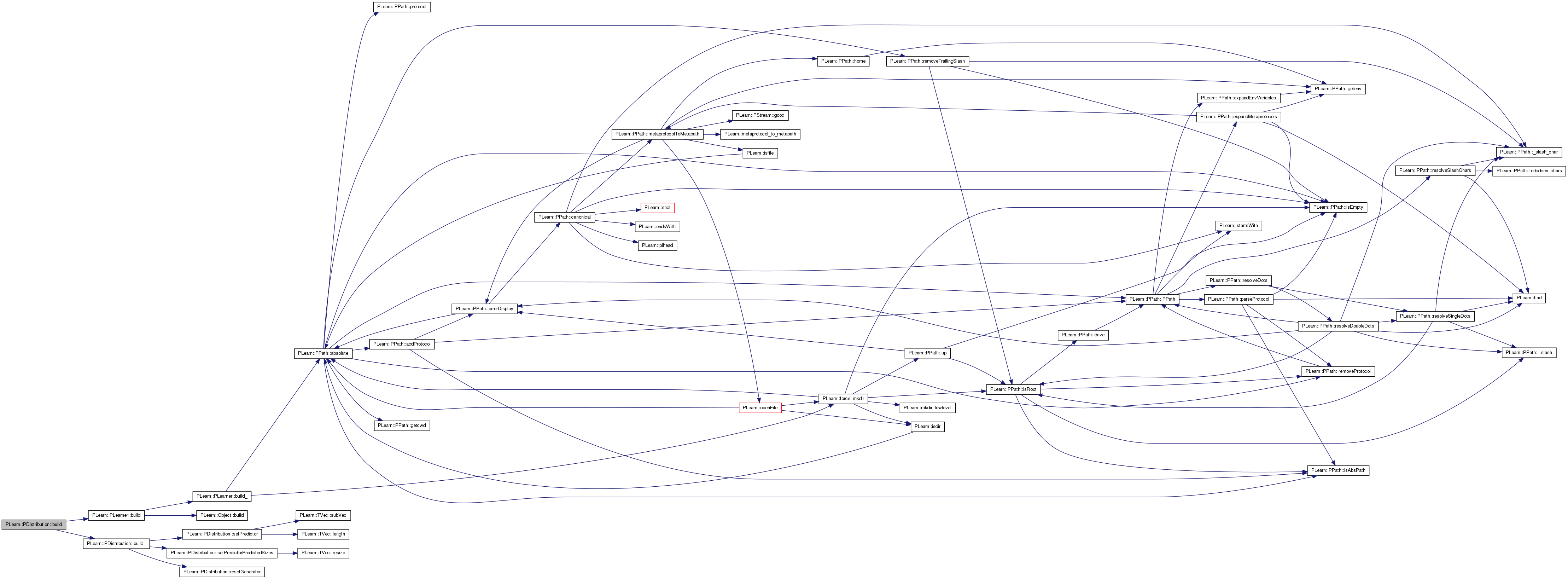
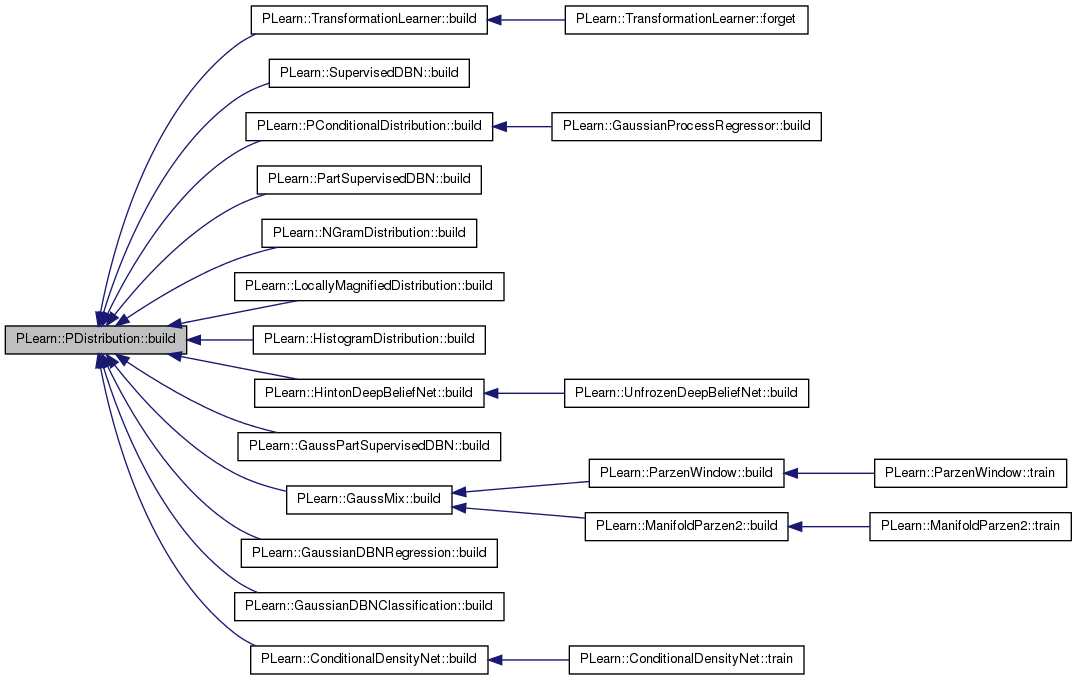
| void PLearn::PDistribution::build_ | ( | ) | [private] |
This does the actual building.
Reimplemented from PLearn::PLearner.
Reimplemented in PLearn::ConditionalDensityNet, PLearn::GaussianContinuumDistribution, PLearn::GaussianProcessRegressor, PLearn::PConditionalDistribution, PLearn::LocallyMagnifiedDistribution, PLearn::NeighborhoodBoxVolumeDensityEstimator, PLearn::TransformationLearner, PLearn::GaussianDistribution, PLearn::GaussMix, PLearn::HistogramDistribution, PLearn::KernelDensityEstimator, PLearn::ManifoldParzen2, PLearn::MixtureDistribution, PLearn::NGramDistribution, PLearn::NonLocalManifoldParzen, PLearn::ParzenWindow, PLearn::RandomGaussMix, PLearn::RBMDistribution, PLearn::SpiralDistribution, PLearn::UnconditionalDistribution, PLearn::UniformDistribution, PLearn::GaussianDBNClassification, PLearn::GaussianDBNRegression, PLearn::GaussPartSupervisedDBN, PLearn::HintonDeepBeliefNet, PLearn::PartSupervisedDBN, PLearn::SupervisedDBN, PLearn::UnfrozenDeepBeliefNet, PLearn::GaussianProcessRegressor, and PLearn::ManifoldKNNDistribution.
Definition at line 228 of file PDistribution.cc.
References delta_curve, lower_bound, n_curve_points, predicted_size, predictor_part, predictor_size, resetGenerator(), PLearn::PLearner::seed_, setPredictor(), setPredictorPredictedSizes(), and upper_bound.
Referenced by build().
{
// Reset the random number generator seed.
resetGenerator(seed_);
// Typical code for a PDistribution: the class makes the operations it
// needs when the predictor and predicted sizes are defined, and when the
// predictor is defined. In the build_() method, it should not call the
// parent's methods since they should have already been called during the
// parent's build.
PDistribution::setPredictorPredictedSizes(predictor_size, predicted_size,
false);
PDistribution::setPredictor(predictor_part, false);
// Set the step between two points in the output curve.
if (n_curve_points > 0)
delta_curve = (upper_bound - lower_bound) / real(n_curve_points);
}

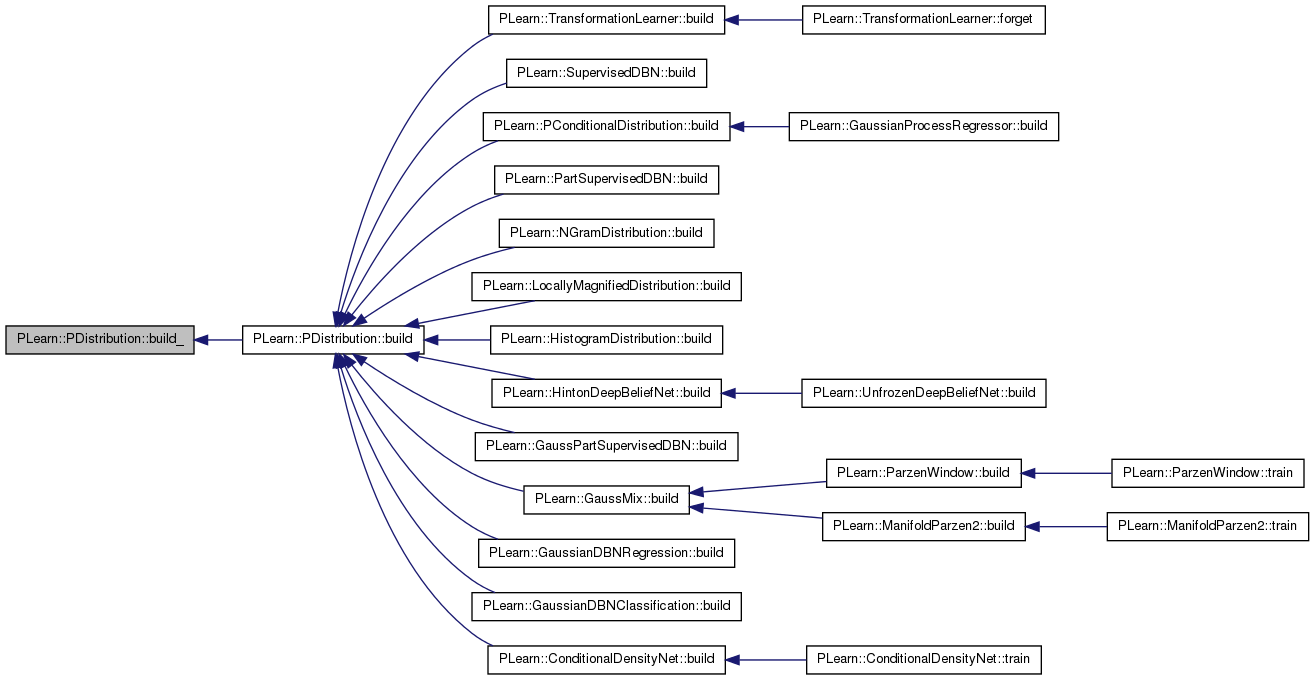
Return cdf: P(Y<y | x).
Reimplemented in PLearn::ConditionalDensityNet, PLearn::GaussMix, PLearn::HistogramDistribution, PLearn::KernelDensityEstimator, PLearn::MixtureDistribution, PLearn::NGramDistribution, PLearn::RBMDistribution, PLearn::SpiralDistribution, PLearn::UniformDistribution, PLearn::GaussianDBNClassification, PLearn::GaussianDBNRegression, PLearn::GaussPartSupervisedDBN, PLearn::HintonDeepBeliefNet, PLearn::PartSupervisedDBN, PLearn::SupervisedDBN, and PLearn::ManifoldKNNDistribution.
Definition at line 569 of file PDistribution.cc.
References PLERROR.
Referenced by computeOutput(), and PLearn::PConditionalDistribution::computeOutput().
{ PLERROR("cdf not implemented for this PDistribution"); return 0; }

| string PLearn::PDistribution::classname | ( | ) | const [virtual] |
Reimplemented from PLearn::Object.
Reimplemented in PLearn::ConditionalDensityNet, PLearn::GaussianContinuumDistribution, PLearn::GaussianProcessRegressor, PLearn::PConditionalDistribution, PLearn::LocallyMagnifiedDistribution, PLearn::NeighborhoodBoxVolumeDensityEstimator, PLearn::TransformationLearner, PLearn::GaussianDistribution, PLearn::GaussMix, PLearn::HistogramDistribution, PLearn::KernelDensityEstimator, PLearn::ManifoldParzen2, PLearn::MixtureDistribution, PLearn::NGramDistribution, PLearn::NonLocalManifoldParzen, PLearn::ParzenWindow, PLearn::RandomGaussMix, PLearn::RBMDistribution, PLearn::SpiralDistribution, PLearn::UnconditionalDistribution, PLearn::UniformDistribution, PLearn::GaussianDBNClassification, PLearn::GaussianDBNRegression, PLearn::GaussPartSupervisedDBN, PLearn::HintonDeepBeliefNet, PLearn::PartSupervisedDBN, PLearn::SupervisedDBN, PLearn::UnfrozenDeepBeliefNet, PLearn::GaussianProcessRegressor, and PLearn::ManifoldKNNDistribution.
Definition at line 110 of file PDistribution.cc.
| void PLearn::PDistribution::computeCostsFromOutputs | ( | const Vec & | input, |
| const Vec & | output, | ||
| const Vec & | target, | ||
| Vec & | costs | ||
| ) | const [virtual] |
Computes negative log likelihood (NLL).
If the first output is neither the log density nor the density, an error will be raised.
Implements PLearn::PLearner.
Reimplemented in PLearn::GaussianProcessRegressor, PLearn::GaussianDBNClassification, PLearn::GaussianDBNRegression, PLearn::GaussPartSupervisedDBN, PLearn::HintonDeepBeliefNet, PLearn::PartSupervisedDBN, PLearn::SupervisedDBN, and PLearn::GaussianProcessRegressor.
Definition at line 352 of file PDistribution.cc.
References c, outputs_def, pl_log, PLERROR, and PLearn::TVec< T >::resize().
Referenced by PLearn::GaussianDBNClassification::computeCostsFromOutputs(), PLearn::HintonDeepBeliefNet::computeCostsFromOutputs(), PLearn::PartSupervisedDBN::computeCostsFromOutputs(), PLearn::GaussPartSupervisedDBN::computeCostsFromOutputs(), PLearn::SupervisedDBN::computeCostsFromOutputs(), and PLearn::GaussianDBNRegression::computeCostsFromOutputs().
{
costs.resize(1);
char c = outputs_def[0];
if(c == 'l')
{
costs[0] = -output[0];
}
else if(c == 'd')
{
costs[0] = -pl_log(output[0]);
}
else
PLERROR("In PDistribution::computeCostsFromOutputs currently can only "
"compute' NLL cost from log likelihood or density returned as "
"first output");
}

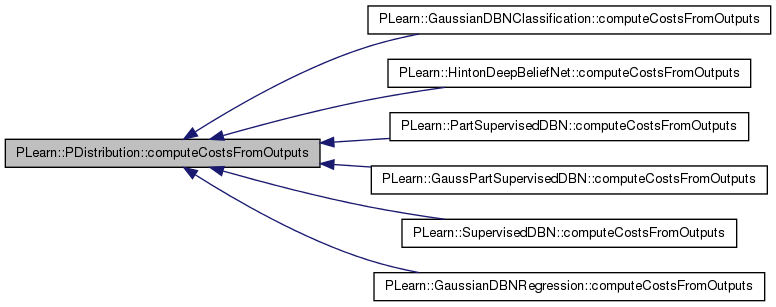
Produce outputs according to what is specified in outputs_def.
Reimplemented from PLearn::PLearner.
Reimplemented in PLearn::GaussianContinuumDistribution, PLearn::GaussianProcessRegressor, PLearn::PConditionalDistribution, PLearn::ManifoldParzen2, PLearn::NonLocalManifoldParzen, and PLearn::GaussianProcessRegressor.
Definition at line 250 of file PDistribution.cc.
References cdf(), delta_curve, density(), expectation(), i, j, log_density(), lower_bound, n_curve_points, n_predicted, outputs_def, outputsize(), PLERROR, predicted_part, PLearn::TVec< T >::resize(), setPredictor(), splitCond(), PLearn::square(), store_cov, store_expect, store_result, PLearn::TVec< T >::subVec(), survival_fn(), PLearn::TVec< T >::toMat(), unknownOutput(), and variance().
Referenced by PLearn::NonLocalManifoldParzen::computeOutput(), PLearn::ManifoldParzen2::computeOutput(), and PLearn::GaussianContinuumDistribution::computeOutput().
{
// TODO Add an output to generate samples.
// Set the 'predictor' (x in P(Y = y| X=x)) and 'predicted' (y) parts.
splitCond(input);
string::size_type l = outputs_def.length();
output.resize(outputsize());
int k = 0;
for(unsigned int i=0; i<l; i++)
{
switch(outputs_def[i])
{
case 'l':
output[k++] = log_density(predicted_part);
break;
case 'd':
output[k++] = density(predicted_part);
break;
case 'c':
output[k++] = cdf(predicted_part);
break;
case 's':
output[k++] = survival_fn(predicted_part);
break;
case 'e':
store_expect = output.subVec(k, n_predicted);
expectation(store_expect);
k += n_predicted;
break;
case 'v':
store_cov =
output.subVec(k, square(n_predicted)).toMat(n_predicted,n_predicted);
variance(store_cov);
k += square(n_predicted);
break;
case 'E':
case 'V':
if (n_predicted > 1)
PLERROR("In PDistribution::computeOutput - Can only plot "
"histogram of expectation or variance for "
"one-dimensional expected part");
if (n_predicted == 0)
PLERROR("In PDistribution::computeOutput - Cannot plot "
"histogram of expectation or variance for "
"unconditional distributions");
case 'L':
case 'D':
case 'C':
case 'S':
real t;
store_result.resize(1);
store_result[0] = lower_bound;
for (int j = 0; j < n_curve_points; j++) {
switch(outputs_def[i]) {
case 'L':
t = log_density(store_result);
break;
case 'D':
t = density(store_result);
break;
case 'C':
t = cdf(store_result);
break;
case 'S':
t = survival_fn(store_result);
break;
case 'E':
setPredictor(store_result);
expectation(store_expect);
t = store_expect[0];
break;
case 'V':
setPredictor(store_result);
store_cov = store_expect.toMat(1,1);
variance(store_cov);
t = store_expect[0];
break;
default:
PLERROR("In PDistribution::computeOutput - This should "
"never happen");
t = 0; // To make the compiler happy.
}
output[j + k] = t;
store_result[0] += delta_curve;
}
k += n_curve_points;
break;
default:
// Maybe a subclass knows about this output?
// TODO This is quite ugly. See how to do this better.
unknownOutput(outputs_def[i], input, output, k);
break;
}
}
}
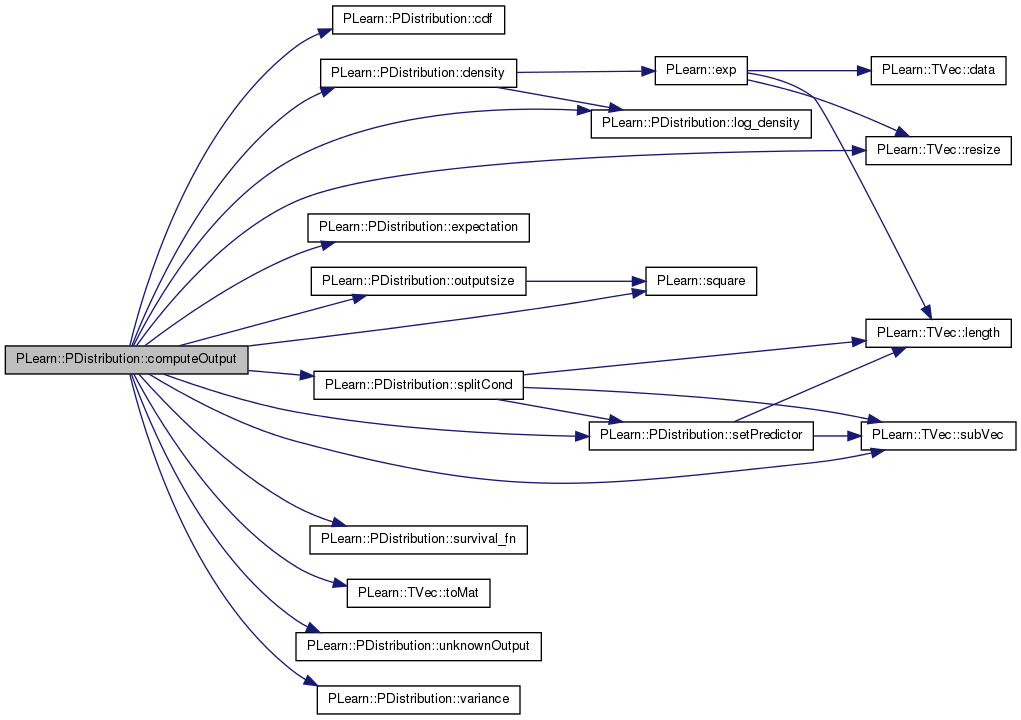

| void PLearn::PDistribution::declareMethods | ( | RemoteMethodMap & | rmm | ) | [static, protected] |
Declare the methods that are remote-callable.
Reimplemented from PLearn::PLearner.
Reimplemented in PLearn::TransformationLearner, and PLearn::GaussianDistribution.
Definition at line 198 of file PDistribution.cc.
References PLearn::PLearner::_getRemoteMethodMap_(), PLearn::declareMethod(), PLearn::RemoteMethodMap::inherited(), log_density(), and remote_generate().
{
// Insert a backpointer to remote methods; note that this
// different from declareOptions()
rmm.inherited(inherited::_getRemoteMethodMap_());
declareMethod(
rmm, "log_density", &PDistribution::log_density,
(BodyDoc("Compute the log density of a data point"),
ArgDoc("sample", "The data point"),
RetDoc("The log density")));
declareMethod(
rmm, "generate", &PDistribution::remote_generate,
(BodyDoc("Generate a sample"),
RetDoc("The generated sample")));
}

| void PLearn::PDistribution::declareOptions | ( | OptionList & | ol | ) | [static, protected] |
Declares this class' options.
Reimplemented from PLearn::PLearner.
Reimplemented in PLearn::ConditionalDensityNet, PLearn::GaussianContinuumDistribution, PLearn::GaussianProcessRegressor, PLearn::PConditionalDistribution, PLearn::LocallyMagnifiedDistribution, PLearn::NeighborhoodBoxVolumeDensityEstimator, PLearn::TransformationLearner, PLearn::GaussianDistribution, PLearn::GaussMix, PLearn::HistogramDistribution, PLearn::KernelDensityEstimator, PLearn::ManifoldParzen2, PLearn::MixtureDistribution, PLearn::NGramDistribution, PLearn::NonLocalManifoldParzen, PLearn::ParzenWindow, PLearn::RandomGaussMix, PLearn::RBMDistribution, PLearn::SpiralDistribution, PLearn::UnconditionalDistribution, PLearn::UniformDistribution, PLearn::GaussianDBNClassification, PLearn::GaussianDBNRegression, PLearn::GaussPartSupervisedDBN, PLearn::HintonDeepBeliefNet, PLearn::PartSupervisedDBN, PLearn::SupervisedDBN, PLearn::UnfrozenDeepBeliefNet, PLearn::GaussianProcessRegressor, and PLearn::ManifoldKNNDistribution.
Definition at line 115 of file PDistribution.cc.
References PLearn::OptionBase::buildoption, PLearn::declareOption(), PLearn::PLearner::declareOptions(), PLearn::OptionBase::learntoption, lower_bound, n_curve_points, n_predicted, n_predictor, outputs_def, predicted_size, predictor_part, predictor_size, and upper_bound.
Referenced by PLearn::TransformationLearner::declareOptions(), PLearn::SupervisedDBN::declareOptions(), PLearn::PConditionalDistribution::declareOptions(), PLearn::PartSupervisedDBN::declareOptions(), PLearn::NGramDistribution::declareOptions(), PLearn::LocallyMagnifiedDistribution::declareOptions(), PLearn::HistogramDistribution::declareOptions(), PLearn::HintonDeepBeliefNet::declareOptions(), PLearn::GaussPartSupervisedDBN::declareOptions(), PLearn::GaussMix::declareOptions(), PLearn::GaussianDBNRegression::declareOptions(), PLearn::GaussianDBNClassification::declareOptions(), and PLearn::ConditionalDensityNet::declareOptions().
{
// Build options.
declareOption(
ol, "outputs_def", &PDistribution::outputs_def,
OptionBase::buildoption,
"Defines what will be given in output. This is a string where the\n"
"characters have the following meaning:\n"
"- 'l' : log_density\n"
"- 'd' : density\n"
"- 'c' : cdf\n"
"- 's' : survival_fn\n"
"- 'e' : expectation\n"
"- 'v' : variance.\n"
"\n"
"If these options are specified in lower case they give the value\n"
"associated with a given observation. In upper case, a curve is\n"
"evaluated at regular intervals and produced in output (as a\n"
"histogram). For 'L', 'D', 'C', 'S', it is the predicted part that\n"
"varies, while for 'E' and 'V' it is the predictor part (for\n"
"conditional distributions).\n"
"The number of curve points is given by the 'n_curve_points' option.\n"
"Note that the upper case letters only work for scalar variables, in\n"
"order to produce a one-dimensional curve."
);
// TODO Make it TVec<string> for better clarity?
declareOption(ol, "predictor_size", &PDistribution::predictor_size,
OptionBase::buildoption,
"The (user-provided) size of the predictor x in p(y|x). A value of\n"
"-1 means the algorithm should find it out by itself.");
declareOption(ol, "predicted_size", &PDistribution::predicted_size,
OptionBase::buildoption,
"The (user-provided) size of the predicted y in p(y|x). A value of\n"
"-1 means the algorithm should find it out by itself.");
declareOption(ol, "predictor_part", &PDistribution::predictor_part,
OptionBase::buildoption,
"In conditional distributions, the predictor part (x in P(Y|X=x)).\n");
declareOption(ol, "n_curve_points", &PDistribution::n_curve_points,
OptionBase::buildoption,
"The number of points for which the output is evaluated when\n"
"outputs_defs is upper case (produces a histogram).\n"
"The lower_bound and upper_bound options specify where the curve\n"
"begins and ends. Note that these options (upper case letters) only\n"
"work for scalar variables.");
declareOption(ol, "lower_bound", &PDistribution::lower_bound,
OptionBase::buildoption,
"The lower bound of scalar Y values to compute a histogram of the\n"
"distribution when upper case outputs_def are specified.");
declareOption(ol, "upper_bound", &PDistribution::upper_bound,
OptionBase::buildoption,
"The upper bound of scalar Y values to compute a histogram of the\n"
"distribution when upper case outputs_def are specified.");
// Learnt options.
declareOption(ol, "n_predictor", &PDistribution::n_predictor,
OptionBase::learntoption,
"The (true) size of the predictor x in p(y|x). If 'predictor_size'\n"
"is non-negative, 'n_predictor' is set to 'predictor_size'.\n"
"Otherwise, it is set to the data dimension minus 'predicted_size'.");
declareOption(ol, "n_predicted", &PDistribution::n_predicted,
OptionBase::learntoption,
"The (true) size of the predicted y in p(y|x). If 'predicted_size'\n"
"is non-negative, 'n_predicted' is set to 'predicted_size'.\n"
"Otherwise, it is set to the data dimension minus 'predictor_size'.");
// Now call the parent class' declareOptions
inherited::declareOptions(ol);
}

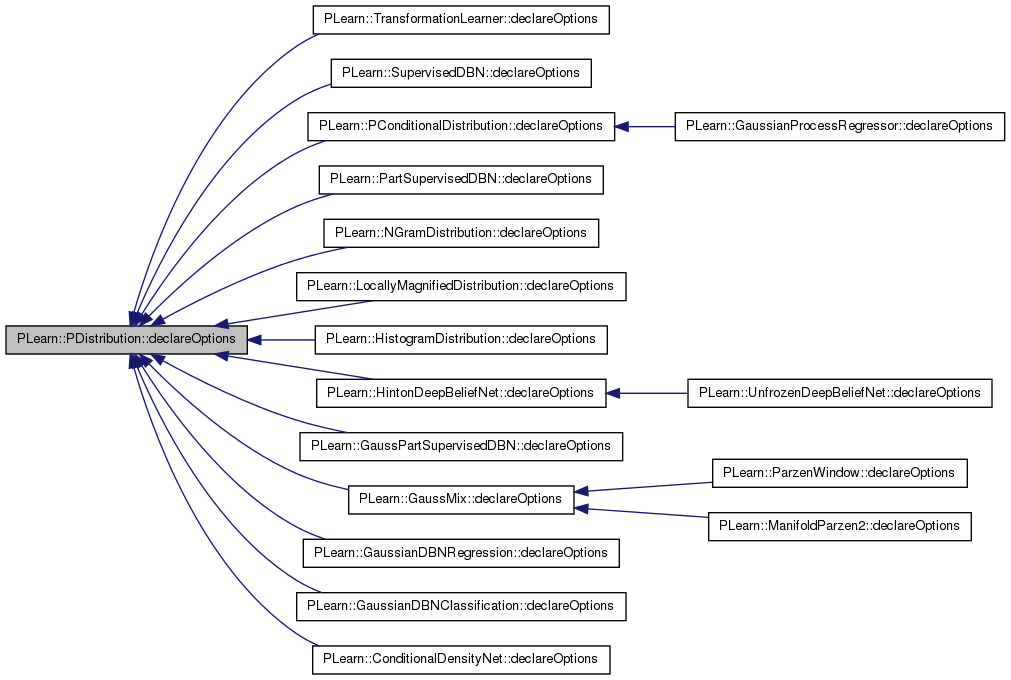
| static const PPath& PLearn::PDistribution::declaringFile | ( | ) | [inline, static] |
Reimplemented from PLearn::PLearner.
Reimplemented in PLearn::ConditionalDensityNet, PLearn::GaussianContinuumDistribution, PLearn::GaussianProcessRegressor, PLearn::PConditionalDistribution, PLearn::LocallyMagnifiedDistribution, PLearn::NeighborhoodBoxVolumeDensityEstimator, PLearn::TransformationLearner, PLearn::GaussianDistribution, PLearn::GaussMix, PLearn::HistogramDistribution, PLearn::KernelDensityEstimator, PLearn::ManifoldParzen2, PLearn::MixtureDistribution, PLearn::NGramDistribution, PLearn::NonLocalManifoldParzen, PLearn::ParzenWindow, PLearn::RandomGaussMix, PLearn::RBMDistribution, PLearn::SpiralDistribution, PLearn::UnconditionalDistribution, PLearn::UniformDistribution, PLearn::GaussianDBNClassification, PLearn::GaussianDBNRegression, PLearn::GaussPartSupervisedDBN, PLearn::HintonDeepBeliefNet, PLearn::PartSupervisedDBN, PLearn::SupervisedDBN, PLearn::UnfrozenDeepBeliefNet, PLearn::GaussianProcessRegressor, and PLearn::ManifoldKNNDistribution.
Definition at line 182 of file PDistribution.h.
:
| PDistribution * PLearn::PDistribution::deepCopy | ( | CopiesMap & | copies | ) | const [virtual] |
Reimplemented from PLearn::PLearner.
Reimplemented in PLearn::ConditionalDensityNet, PLearn::GaussianContinuumDistribution, PLearn::GaussianProcessRegressor, PLearn::PConditionalDistribution, PLearn::LocallyMagnifiedDistribution, PLearn::NeighborhoodBoxVolumeDensityEstimator, PLearn::TransformationLearner, PLearn::GaussianDistribution, PLearn::GaussMix, PLearn::HistogramDistribution, PLearn::KernelDensityEstimator, PLearn::ManifoldParzen2, PLearn::MixtureDistribution, PLearn::NGramDistribution, PLearn::NonLocalManifoldParzen, PLearn::ParzenWindow, PLearn::RandomGaussMix, PLearn::RBMDistribution, PLearn::SpiralDistribution, PLearn::UnconditionalDistribution, PLearn::UniformDistribution, PLearn::GaussianDBNClassification, PLearn::GaussianDBNRegression, PLearn::GaussPartSupervisedDBN, PLearn::HintonDeepBeliefNet, PLearn::PartSupervisedDBN, PLearn::SupervisedDBN, PLearn::UnfrozenDeepBeliefNet, PLearn::GaussianProcessRegressor, and PLearn::ManifoldKNNDistribution.
Definition at line 110 of file PDistribution.cc.
Return probability density p(y | x) (default version simply returns exp(log_density(y))).
Reimplemented in PLearn::HistogramDistribution, PLearn::NGramDistribution, PLearn::GaussianDBNClassification, PLearn::GaussianDBNRegression, PLearn::GaussPartSupervisedDBN, PLearn::HintonDeepBeliefNet, PLearn::PartSupervisedDBN, and PLearn::SupervisedDBN.
Definition at line 563 of file PDistribution.cc.
References PLearn::exp(), and log_density().
Referenced by computeOutput(), and PLearn::PConditionalDistribution::computeOutput().
{ return exp(log_density(y)); }


| void PLearn::PDistribution::expectation | ( | Vec & | mu | ) | const [virtual] |
Return E[Y | x].
Reimplemented in PLearn::ConditionalDensityNet, PLearn::GaussMix, PLearn::HistogramDistribution, PLearn::KernelDensityEstimator, PLearn::MixtureDistribution, PLearn::NGramDistribution, PLearn::RBMDistribution, PLearn::SpiralDistribution, PLearn::UniformDistribution, PLearn::GaussianDBNClassification, PLearn::GaussianDBNRegression, PLearn::GaussPartSupervisedDBN, PLearn::HintonDeepBeliefNet, PLearn::PartSupervisedDBN, PLearn::SupervisedDBN, and PLearn::ManifoldKNNDistribution.
Definition at line 572 of file PDistribution.cc.
References PLERROR.
Referenced by computeOutput(), and PLearn::PConditionalDistribution::computeOutput().
{ PLERROR("expectation not implemented for this PDistribution"); }

| void PLearn::PDistribution::forget | ( | ) | [virtual] |
(Re-)initializes the PLearner in its fresh state (that state may depend on the 'seed' option) And sets 'stage' back to 0 (this is the stage of a fresh learner!)
Reimplemented from PLearn::PLearner.
Reimplemented in PLearn::ConditionalDensityNet, PLearn::GaussianContinuumDistribution, PLearn::GaussianProcessRegressor, PLearn::LocallyMagnifiedDistribution, PLearn::NeighborhoodBoxVolumeDensityEstimator, PLearn::TransformationLearner, PLearn::GaussianDistribution, PLearn::GaussMix, PLearn::KernelDensityEstimator, PLearn::MixtureDistribution, PLearn::NGramDistribution, PLearn::NonLocalManifoldParzen, PLearn::RBMDistribution, PLearn::UnconditionalDistribution, PLearn::GaussianDBNClassification, PLearn::GaussianDBNRegression, PLearn::GaussPartSupervisedDBN, PLearn::HintonDeepBeliefNet, PLearn::PartSupervisedDBN, PLearn::SupervisedDBN, PLearn::GaussianProcessRegressor, and PLearn::ManifoldKNNDistribution.
Definition at line 549 of file PDistribution.cc.
References n_predicted, n_predictor, resetGenerator(), PLearn::PLearner::seed_, and PLearn::PLearner::stage.
Referenced by PLearn::TransformationLearner::forget(), and PLearn::GaussMix::forget().
{
stage = 0;
n_predictor = -1;
n_predicted = -1;
resetGenerator(seed_);
}


| void PLearn::PDistribution::generate | ( | Vec & | y | ) | const [virtual] |
Return a pseudo-random sample generated from the conditional distribution, of density p(y | x).
Reimplemented in PLearn::ConditionalDensityNet, PLearn::TransformationLearner, PLearn::GaussianDistribution, PLearn::GaussMix, PLearn::KernelDensityEstimator, PLearn::MixtureDistribution, PLearn::NGramDistribution, PLearn::RBMDistribution, PLearn::SpiralDistribution, PLearn::UniformDistribution, PLearn::GaussianDBNClassification, PLearn::GaussianDBNRegression, PLearn::GaussPartSupervisedDBN, PLearn::HintonDeepBeliefNet, PLearn::PartSupervisedDBN, PLearn::SupervisedDBN, and PLearn::ManifoldKNNDistribution.
Definition at line 581 of file PDistribution.cc.
References PLERROR.
Referenced by generateJoint(), generateN(), and remote_generate().
{ PLERROR("generate not implemented for this PDistribution"); }

| void PLearn::PDistribution::generateJoint | ( | Vec & | xy | ) | [virtual] |
Generates a pseudo-random sample (x,y) from the JOINT distribution, of density p(x, y) i.e., generates a predictor and a predicted part, regardless of any previously set predictor.
Reimplemented in PLearn::UnconditionalDistribution.
Definition at line 584 of file PDistribution.cc.
References generate(), n_predicted, n_predictor, and setPredictorPredictedSizes().
Referenced by generateJoint(), generatePredicted(), and generatePredictor().
{
// get old sizes
int old_n_predictor = n_predictor;
int old_n_predicted = n_predicted;
// set all inputs as predicted to generate a joint sample
setPredictorPredictedSizes(0, -1);
generate( xy );
// restore old sizes
setPredictorPredictedSizes(old_n_predictor, old_n_predicted);
}


Generates a pseudo-random sample (x,y) from the JOINT distribution, of density p(x, y), split in two vectors i.e., generates a predictor and a predicted part, regardless of any previously set predictor.
Definition at line 598 of file PDistribution.cc.
References generateJoint(), n_predicted, n_predictor, and PLearn::TVec< T >::subVec().
{
Vec joint_sample;
generateJoint( joint_sample );
x = joint_sample.subVec(0, n_predictor);
y = joint_sample.subVec(n_predictor, n_predicted);
}

| void PLearn::PDistribution::generateN | ( | const Mat & | Y | ) | const [virtual] |
X must be a N x n_predicted matrix.
that will be filled. This will call generate N times to fill the N rows of the matrix.
Reimplemented in PLearn::RBMDistribution.
Definition at line 395 of file PDistribution.cc.
References generate(), i, PLearn::TMat< T >::length(), N, n_predicted, PLERROR, PLearn::PLearner::report_progress, and PLearn::TMat< T >::width().
{
Vec v;
if (Y.width() != n_predicted)
PLERROR("In PDistribution::generateN - Matrix width (%d) differs from "
"n_predicted (%d)", Y.width(), n_predicted);
int N = Y.length();
PP<ProgressBar> pb =
report_progress ? new ProgressBar("Generating samples", N)
: NULL;
for(int i=0; i<N; i++)
{
v = Y(i);
generate(v);
if (pb)
pb->update(i);
}
}

| void PLearn::PDistribution::generatePredicted | ( | Vec & | y | ) | [virtual] |
Generates a pseudo-random sample y from the marginal distribution of predicted parts, of density p(y) (and NOT p(y | x)).
i.e., generates a predicted part, regardless of any previously set predictor.
Reimplemented in PLearn::UnconditionalDistribution.
Definition at line 612 of file PDistribution.cc.
References generateJoint(), and x.
{
Vec x;
generateJoint(x, y);
}

| void PLearn::PDistribution::generatePredictor | ( | Vec & | x | ) | [virtual] |
Generates a pseudo-random sample x from the marginal distribution of predictors, of density p(x), i.e., generates a predictor part, regardless of any previously set predictor.
Reimplemented in PLearn::UnconditionalDistribution.
Definition at line 606 of file PDistribution.cc.
References generateJoint().
{
Vec y;
generateJoint(x, y);
}

Generates a pseudo-random sample x from the reversed conditional distribution, of density p(x | y) (and NOT p(y | x)).
i.e., generates a "predictor" part given a "predicted" part, regardless of any previously set predictor.
Reimplemented in PLearn::UnconditionalDistribution.
Definition at line 618 of file PDistribution.cc.
References PLERROR.
{ PLERROR("generatePredictorGivenPredicted not implemented for this\n"
"PDistribution\n"); }
| int PLearn::PDistribution::getNPredicted | ( | ) | const [inline] |
'Get' accessor for n_predicted.
Definition at line 340 of file PDistribution.h.
{ return n_predicted; }
| int PLearn::PDistribution::getNPredictor | ( | ) | const [inline] |
'Get' accessor for n_predictor.
Definition at line 343 of file PDistribution.h.
{ return n_predictor; }
| OptionList & PLearn::PDistribution::getOptionList | ( | ) | const [virtual] |
Reimplemented from PLearn::Object.
Reimplemented in PLearn::ConditionalDensityNet, PLearn::GaussianContinuumDistribution, PLearn::GaussianProcessRegressor, PLearn::PConditionalDistribution, PLearn::LocallyMagnifiedDistribution, PLearn::NeighborhoodBoxVolumeDensityEstimator, PLearn::TransformationLearner, PLearn::GaussianDistribution, PLearn::GaussMix, PLearn::HistogramDistribution, PLearn::KernelDensityEstimator, PLearn::ManifoldParzen2, PLearn::MixtureDistribution, PLearn::NGramDistribution, PLearn::NonLocalManifoldParzen, PLearn::ParzenWindow, PLearn::RandomGaussMix, PLearn::RBMDistribution, PLearn::SpiralDistribution, PLearn::UnconditionalDistribution, PLearn::UniformDistribution, PLearn::GaussianDBNClassification, PLearn::GaussianDBNRegression, PLearn::GaussPartSupervisedDBN, PLearn::HintonDeepBeliefNet, PLearn::PartSupervisedDBN, PLearn::SupervisedDBN, PLearn::UnfrozenDeepBeliefNet, PLearn::GaussianProcessRegressor, and PLearn::ManifoldKNNDistribution.
Definition at line 110 of file PDistribution.cc.
| OptionMap & PLearn::PDistribution::getOptionMap | ( | ) | const [virtual] |
Reimplemented from PLearn::Object.
Reimplemented in PLearn::ConditionalDensityNet, PLearn::GaussianContinuumDistribution, PLearn::GaussianProcessRegressor, PLearn::PConditionalDistribution, PLearn::LocallyMagnifiedDistribution, PLearn::NeighborhoodBoxVolumeDensityEstimator, PLearn::TransformationLearner, PLearn::GaussianDistribution, PLearn::GaussMix, PLearn::HistogramDistribution, PLearn::KernelDensityEstimator, PLearn::ManifoldParzen2, PLearn::MixtureDistribution, PLearn::NGramDistribution, PLearn::NonLocalManifoldParzen, PLearn::ParzenWindow, PLearn::RandomGaussMix, PLearn::RBMDistribution, PLearn::SpiralDistribution, PLearn::UnconditionalDistribution, PLearn::UniformDistribution, PLearn::GaussianDBNClassification, PLearn::GaussianDBNRegression, PLearn::GaussPartSupervisedDBN, PLearn::HintonDeepBeliefNet, PLearn::PartSupervisedDBN, PLearn::SupervisedDBN, PLearn::UnfrozenDeepBeliefNet, PLearn::GaussianProcessRegressor, and PLearn::ManifoldKNNDistribution.
Definition at line 110 of file PDistribution.cc.
| RemoteMethodMap & PLearn::PDistribution::getRemoteMethodMap | ( | ) | const [virtual] |
Reimplemented from PLearn::Object.
Reimplemented in PLearn::ConditionalDensityNet, PLearn::GaussianContinuumDistribution, PLearn::GaussianProcessRegressor, PLearn::PConditionalDistribution, PLearn::LocallyMagnifiedDistribution, PLearn::NeighborhoodBoxVolumeDensityEstimator, PLearn::TransformationLearner, PLearn::GaussianDistribution, PLearn::GaussMix, PLearn::HistogramDistribution, PLearn::KernelDensityEstimator, PLearn::ManifoldParzen2, PLearn::MixtureDistribution, PLearn::NGramDistribution, PLearn::NonLocalManifoldParzen, PLearn::ParzenWindow, PLearn::RandomGaussMix, PLearn::RBMDistribution, PLearn::SpiralDistribution, PLearn::UnconditionalDistribution, PLearn::UniformDistribution, PLearn::GaussianDBNClassification, PLearn::GaussianDBNRegression, PLearn::GaussPartSupervisedDBN, PLearn::HintonDeepBeliefNet, PLearn::PartSupervisedDBN, PLearn::SupervisedDBN, PLearn::UnfrozenDeepBeliefNet, PLearn::GaussianProcessRegressor, and PLearn::ManifoldKNNDistribution.
Definition at line 110 of file PDistribution.cc.
| TVec< string > PLearn::PDistribution::getTestCostNames | ( | ) | const [virtual] |
Return [ "NLL" ] (the only cost computed by a PDistribution).
Implements PLearn::PLearner.
Reimplemented in PLearn::GaussianProcessRegressor, PLearn::GaussianDBNClassification, PLearn::GaussianDBNRegression, PLearn::GaussPartSupervisedDBN, PLearn::HintonDeepBeliefNet, PLearn::PartSupervisedDBN, PLearn::SupervisedDBN, and PLearn::GaussianProcessRegressor.
Definition at line 374 of file PDistribution.cc.
References PLearn::TVec< T >::append(), and PLearn::TVec< T >::isEmpty().
Referenced by PLearn::ConditionalDensityNet::getTrainCostNames().
{
TVec<string> nll_cost;
if (nll_cost.isEmpty())
nll_cost.append("NLL");
return nll_cost;
}


| TVec< string > PLearn::PDistribution::getTrainCostNames | ( | ) | const [virtual] |
Return [ ].
Implements PLearn::PLearner.
Reimplemented in PLearn::ConditionalDensityNet, PLearn::GaussianProcessRegressor, PLearn::GaussMix, PLearn::GaussPartSupervisedDBN, PLearn::HintonDeepBeliefNet, PLearn::PartSupervisedDBN, PLearn::SupervisedDBN, and PLearn::GaussianProcessRegressor.
Definition at line 385 of file PDistribution.cc.
{
// Default = no train cost computed. This may be overridden in subclasses.
TVec<string> no_cost;
return no_cost;
}
Return log of probability density log(p(y | x)).
Reimplemented in PLearn::ConditionalDensityNet, PLearn::GaussianContinuumDistribution, PLearn::GaussianProcessRegressor, PLearn::LocallyMagnifiedDistribution, PLearn::NeighborhoodBoxVolumeDensityEstimator, PLearn::TransformationLearner, PLearn::GaussianDistribution, PLearn::GaussMix, PLearn::HistogramDistribution, PLearn::KernelDensityEstimator, PLearn::MixtureDistribution, PLearn::NGramDistribution, PLearn::NonLocalManifoldParzen, PLearn::RBMDistribution, PLearn::SpiralDistribution, PLearn::UniformDistribution, PLearn::GaussianDBNClassification, PLearn::GaussianDBNRegression, PLearn::GaussPartSupervisedDBN, PLearn::HintonDeepBeliefNet, PLearn::PartSupervisedDBN, PLearn::SupervisedDBN, and PLearn::ManifoldKNNDistribution.
Definition at line 560 of file PDistribution.cc.
References PLERROR.
Referenced by computeOutput(), PLearn::PConditionalDistribution::computeOutput(), declareMethods(), and density().
{ PLERROR("density not implemented for this PDistribution"); return 0; }

| void PLearn::PDistribution::makeDeepCopyFromShallowCopy | ( | CopiesMap & | copies | ) | [virtual] |
Transforms a shallow copy into a deep copy.
Reimplemented from PLearn::PLearner.
Reimplemented in PLearn::ConditionalDensityNet, PLearn::GaussianContinuumDistribution, PLearn::GaussianProcessRegressor, PLearn::PConditionalDistribution, PLearn::LocallyMagnifiedDistribution, PLearn::NeighborhoodBoxVolumeDensityEstimator, PLearn::TransformationLearner, PLearn::GaussianDistribution, PLearn::GaussMix, PLearn::HistogramDistribution, PLearn::KernelDensityEstimator, PLearn::ManifoldParzen2, PLearn::MixtureDistribution, PLearn::NGramDistribution, PLearn::NonLocalManifoldParzen, PLearn::ParzenWindow, PLearn::RandomGaussMix, PLearn::RBMDistribution, PLearn::SpiralDistribution, PLearn::UnconditionalDistribution, PLearn::UniformDistribution, PLearn::GaussianDBNClassification, PLearn::GaussianDBNRegression, PLearn::GaussPartSupervisedDBN, PLearn::HintonDeepBeliefNet, PLearn::PartSupervisedDBN, PLearn::SupervisedDBN, PLearn::UnfrozenDeepBeliefNet, PLearn::GaussianProcessRegressor, and PLearn::ManifoldKNNDistribution.
Definition at line 417 of file PDistribution.cc.
References PLearn::deepCopyField(), PLearn::PLearner::makeDeepCopyFromShallowCopy(), predicted_part, predictor_part, store_cov, store_expect, and store_result.
Referenced by PLearn::TransformationLearner::makeDeepCopyFromShallowCopy(), PLearn::SupervisedDBN::makeDeepCopyFromShallowCopy(), PLearn::PConditionalDistribution::makeDeepCopyFromShallowCopy(), PLearn::PartSupervisedDBN::makeDeepCopyFromShallowCopy(), PLearn::NGramDistribution::makeDeepCopyFromShallowCopy(), PLearn::LocallyMagnifiedDistribution::makeDeepCopyFromShallowCopy(), PLearn::HistogramDistribution::makeDeepCopyFromShallowCopy(), PLearn::HintonDeepBeliefNet::makeDeepCopyFromShallowCopy(), PLearn::GaussPartSupervisedDBN::makeDeepCopyFromShallowCopy(), PLearn::GaussMix::makeDeepCopyFromShallowCopy(), PLearn::GaussianDBNRegression::makeDeepCopyFromShallowCopy(), PLearn::GaussianDBNClassification::makeDeepCopyFromShallowCopy(), and PLearn::ConditionalDensityNet::makeDeepCopyFromShallowCopy().
{
inherited::makeDeepCopyFromShallowCopy(copies);
deepCopyField(store_expect, copies);
deepCopyField(store_result, copies);
deepCopyField(store_cov, copies);
deepCopyField(predictor_part, copies);
deepCopyField(predicted_part, copies);
}

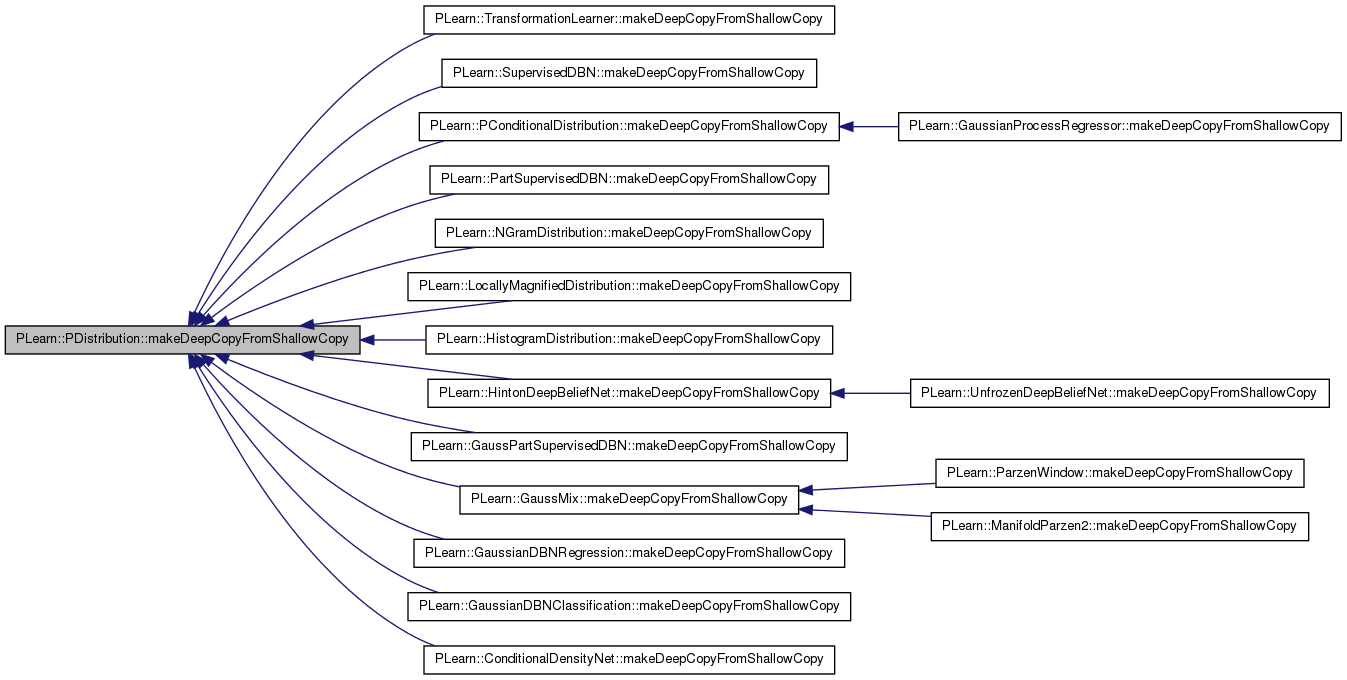
Return E[Y | x] where Y is the missing part in the 'input' vector, and x in the observed part (thus discarding any current setting of predictor and predicted sizes).
The values in return vector 'mu' are ordered like the missing values in 'input'. This method must be implemented in sub-classes, as the default behavior is to throw an error.
Reimplemented in PLearn::GaussMix.
Definition at line 575 of file PDistribution.cc.
References PLERROR.
{ PLERROR("missingExpectation not implemented for this PDistribution"); }
| int PLearn::PDistribution::outputsize | ( | ) | const [virtual] |
Returned value depends on outputs_def.
Implements PLearn::PLearner.
Reimplemented in PLearn::GaussianContinuumDistribution, PLearn::GaussianProcessRegressor, PLearn::GaussMix, PLearn::ManifoldParzen2, PLearn::NonLocalManifoldParzen, and PLearn::GaussianProcessRegressor.
Definition at line 430 of file PDistribution.cc.
References i, n_curve_points, n_predicted, outputs_def, and PLearn::square().
Referenced by computeOutput(), PLearn::GaussMix::outputsize(), PLearn::NonLocalManifoldParzen::outputsize(), and PLearn::GaussianContinuumDistribution::outputsize().
{
int l = 0;
for (size_t i=0; i<outputs_def.length(); i++) {
if (outputs_def[i]=='L' || outputs_def[i]=='D' || outputs_def[i]=='C'
|| outputs_def[i]=='S' || outputs_def[i]=='E' || outputs_def[i]=='V')
l+=n_curve_points;
else if (outputs_def[i]=='e')
l += n_predicted;
else if (outputs_def[i]=='v')
// Variance is full (n x n) matrix.
l += square(n_predicted);
else l++;
}
return l;
}


| Vec PLearn::PDistribution::remote_generate | ( | ) |
Remote interface for 'generate'.
Definition at line 451 of file PDistribution.cc.
References generate(), and PLearn::sample().
Referenced by declareMethods().


| void PLearn::PDistribution::resetGenerator | ( | long | g_seed | ) | [virtual] |
Reset the random number generator used by generate() using the given seed.
Default behavior is to call random_gen->manual_seed(g_seed) and to save the given seed. This method is called in build(). Exception: if 'g_seed' is zero, then do nothing.
Reimplemented in PLearn::ConditionalDensityNet, PLearn::KernelDensityEstimator, PLearn::MixtureDistribution, PLearn::RBMDistribution, and PLearn::UniformDistribution.
Definition at line 461 of file PDistribution.cc.
References PLearn::PLearner::random_gen, and PLearn::PLearner::seed_.
Referenced by build_(), PLearn::SupervisedDBN::forget(), PLearn::HintonDeepBeliefNet::forget(), forget(), PLearn::PartSupervisedDBN::forget(), PLearn::GaussPartSupervisedDBN::forget(), PLearn::GaussianDBNClassification::forget(), PLearn::GaussianDBNRegression::forget(), PLearn::RBMDistribution::resetGenerator(), PLearn::KernelDensityEstimator::resetGenerator(), and PLearn::UniformDistribution::resetGenerator().
{
if (g_seed != 0) {
seed_ = g_seed;
random_gen->manual_seed(g_seed);
}
}
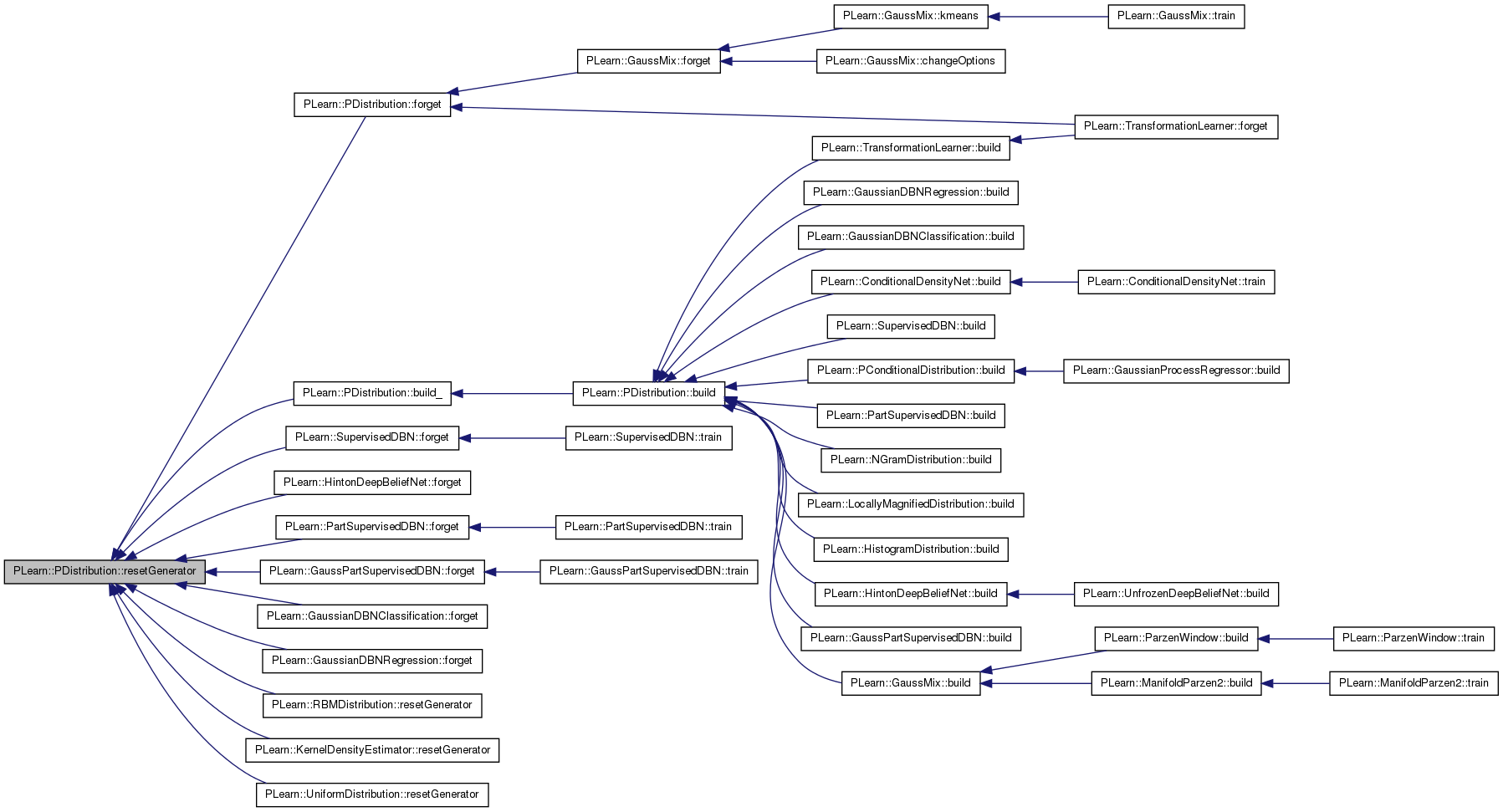
| void PLearn::PDistribution::setPredictor | ( | const Vec & | predictor, |
| bool | call_parent = true |
||
| ) | const [virtual] |
Set the value for the predictor part of a conditional probability.
This needs to be implemented in subclasses if there is something special to do (like precomputing some data). The default behavior is just to fill 'predictor_part' with the first 'n_predictor' elements of 'predictor'. As with 'setPredictorPredictedSizes(..)', the boolean 'call_parent' indicates whether or not one should call inherited::setPredictor(..) with the same arguments.
Reimplemented in PLearn::GaussMix, PLearn::MixtureDistribution, PLearn::UnconditionalDistribution, PLearn::GaussianDBNClassification, PLearn::GaussianDBNRegression, PLearn::GaussPartSupervisedDBN, PLearn::HintonDeepBeliefNet, PLearn::PartSupervisedDBN, and PLearn::SupervisedDBN.
Definition at line 472 of file PDistribution.cc.
References PLearn::TVec< T >::length(), n_predictor, PLASSERT, predictor_part, and PLearn::TVec< T >::subVec().
Referenced by build_(), computeOutput(), PLearn::SupervisedDBN::setPredictor(), PLearn::GaussianDBNClassification::setPredictor(), PLearn::GaussPartSupervisedDBN::setPredictor(), PLearn::PartSupervisedDBN::setPredictor(), PLearn::HintonDeepBeliefNet::setPredictor(), PLearn::GaussMix::setPredictor(), PLearn::GaussianDBNRegression::setPredictor(), and splitCond().
{
// Default behavior: only fill 'predictor_part' with first elements of
// 'predictor'.
PLASSERT( predictor.length() >= n_predictor );
PLASSERT( predictor_part.length() == n_predictor );
if (predictor != predictor_part)
predictor_part << predictor.subVec(0, n_predictor);
}

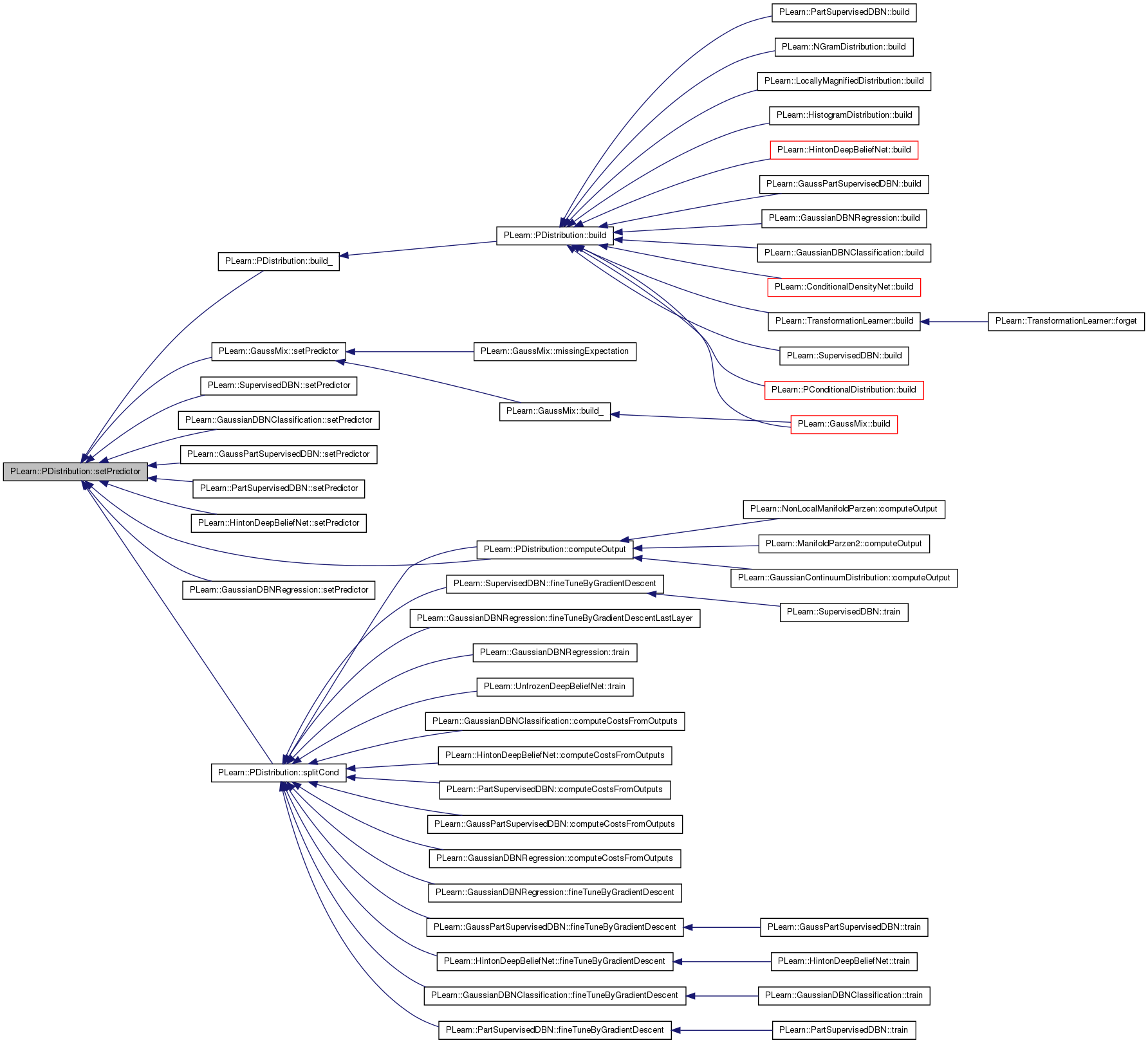
| bool PLearn::PDistribution::setPredictorPredictedSizes | ( | int | the_predictor_size, |
| int | the_predicted_size, | ||
| bool | call_parent = true |
||
| ) | [virtual] |
Set the 'predictor' and 'predicted' sizes for this distribution.
'the_predictor_size' is the size of the predictor, i.e. of x in p(y|x). 'the_predicted_size' is the size of the predicted, i.e. of y in p(y|x). This is a virtual method: if 'call_parent' is set to true, then the inherited::setPredictorPredictedSizes(..) method will also be called, with the same arguments: this is useful in the build process, where each class is able to call only its own method by setting 'call_parent' to false. If 'call_parent' is true, returns 'true' iff the predictor or predicted sizes have been modified from their previous value. If 'call_parent' is false, returns 'false'.
Reimplemented in PLearn::GaussMix, PLearn::MixtureDistribution, PLearn::GaussianDBNClassification, PLearn::GaussianDBNRegression, PLearn::GaussPartSupervisedDBN, PLearn::HintonDeepBeliefNet, PLearn::PartSupervisedDBN, and PLearn::SupervisedDBN.
Definition at line 485 of file PDistribution.cc.
References PLearn::PLearner::inputsize_, n_predicted, n_predictor, PLASSERT, PLERROR, predicted_part, predicted_size, predictor_part, predictor_size, and PLearn::TVec< T >::resize().
Referenced by build_(), generateJoint(), PLearn::GaussianDBNRegression::setPredictorPredictedSizes(), PLearn::GaussianDBNClassification::setPredictorPredictedSizes(), PLearn::HintonDeepBeliefNet::setPredictorPredictedSizes(), PLearn::GaussMix::setPredictorPredictedSizes(), PLearn::GaussPartSupervisedDBN::setPredictorPredictedSizes(), PLearn::PartSupervisedDBN::setPredictorPredictedSizes(), and PLearn::SupervisedDBN::setPredictorPredictedSizes().
{
PLASSERT( (the_predictor_size >= 0 || the_predictor_size == -1) &&
(the_predicted_size >= 0 || the_predicted_size == -1) );
int backup_n_predictor = n_predictor;
int backup_n_predicted = n_predicted;
n_predictor = predictor_size = the_predictor_size;
n_predicted = predicted_size = the_predicted_size;
if (n_predictor < 0) {
if (n_predicted < 0)
PLERROR("In PDistribution::setPredictorPredictedSizes - You need"
"to specify at least one non-negative value");
if (inputsize_ >= 0) {
if (n_predicted > inputsize_)
PLERROR("In PDistribution::setPredictorPredictedSizes - "
"'n_predicted' (%d) cannot be > inputsize (%d)",
n_predicted, inputsize_);
n_predictor = inputsize_ - n_predicted;
}
} else if (n_predicted < 0) {
if (inputsize_ >= 0) {
if (n_predictor > inputsize_)
PLERROR("In PDistribution::setPredictorPredictedSizes - "
"'n_predictor' (%d) cannot be > inputsize (%d)",
n_predictor, inputsize_);
n_predicted = inputsize_ - n_predictor;
}
}
if (inputsize_ >= 0 && n_predictor + n_predicted != inputsize_)
PLERROR("In PDistribution::setPredictorPredictedSizes - n_predictor "
"(%d) + n_predicted (%d) != inputsize (%d)",
n_predictor, n_predicted, inputsize_);
if (n_predictor >= 0)
predictor_part.resize(n_predictor);
if (n_predicted >= 0)
predicted_part.resize(n_predicted);
if (!call_parent)
return false;
else
return (n_predictor != backup_n_predictor ||
n_predicted != backup_n_predicted);
}

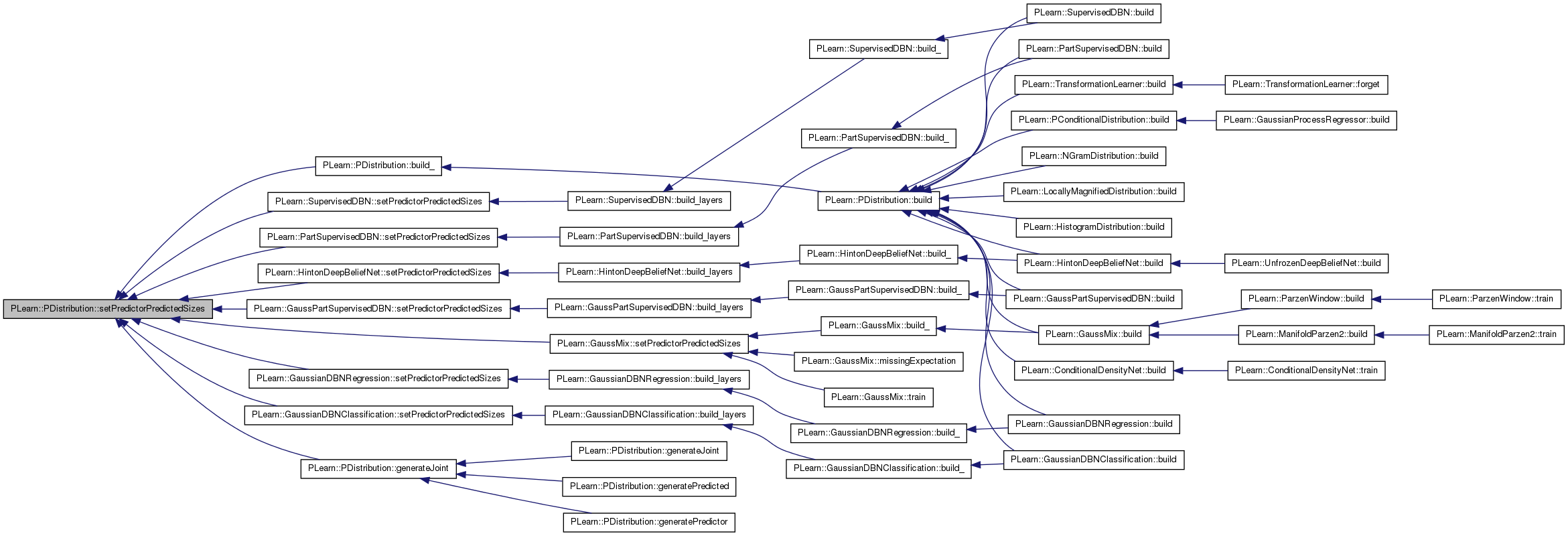
| void PLearn::PDistribution::splitCond | ( | const Vec & | input | ) | const [protected] |
Split an input into the part corresponding to the predictor (in 'predictor_part'), and the predicted (in 'predicted_part').
Also call setPredictor(..) with the new predictor part. If 'input' turns out to only have a predicted part (i.e. its length is equal to 'n_predicted'), then no predictor part will be set (it is assumed to stay the same as before).
Definition at line 533 of file PDistribution.cc.
References PLearn::TVec< T >::length(), n_predicted, n_predictor, PLASSERT, predicted_part, setPredictor(), and PLearn::TVec< T >::subVec().
Referenced by PLearn::GaussianDBNClassification::computeCostsFromOutputs(), PLearn::HintonDeepBeliefNet::computeCostsFromOutputs(), PLearn::PartSupervisedDBN::computeCostsFromOutputs(), PLearn::GaussPartSupervisedDBN::computeCostsFromOutputs(), PLearn::GaussianDBNRegression::computeCostsFromOutputs(), computeOutput(), PLearn::GaussianDBNRegression::fineTuneByGradientDescent(), PLearn::GaussPartSupervisedDBN::fineTuneByGradientDescent(), PLearn::HintonDeepBeliefNet::fineTuneByGradientDescent(), PLearn::GaussianDBNClassification::fineTuneByGradientDescent(), PLearn::PartSupervisedDBN::fineTuneByGradientDescent(), PLearn::SupervisedDBN::fineTuneByGradientDescent(), PLearn::GaussianDBNRegression::fineTuneByGradientDescentLastLayer(), PLearn::GaussianDBNRegression::train(), and PLearn::UnfrozenDeepBeliefNet::train().
{
if (n_predictor == 0 || (n_predictor > 0 && input.length() == n_predicted))
{
// No predictor part provided: this means this is the same as before
// (or that there is none at all).
predicted_part << input;
} else {
PLASSERT( input.length() == n_predictor + n_predicted );
predicted_part << input.subVec(n_predictor, n_predicted);
setPredictor(input);
}
}

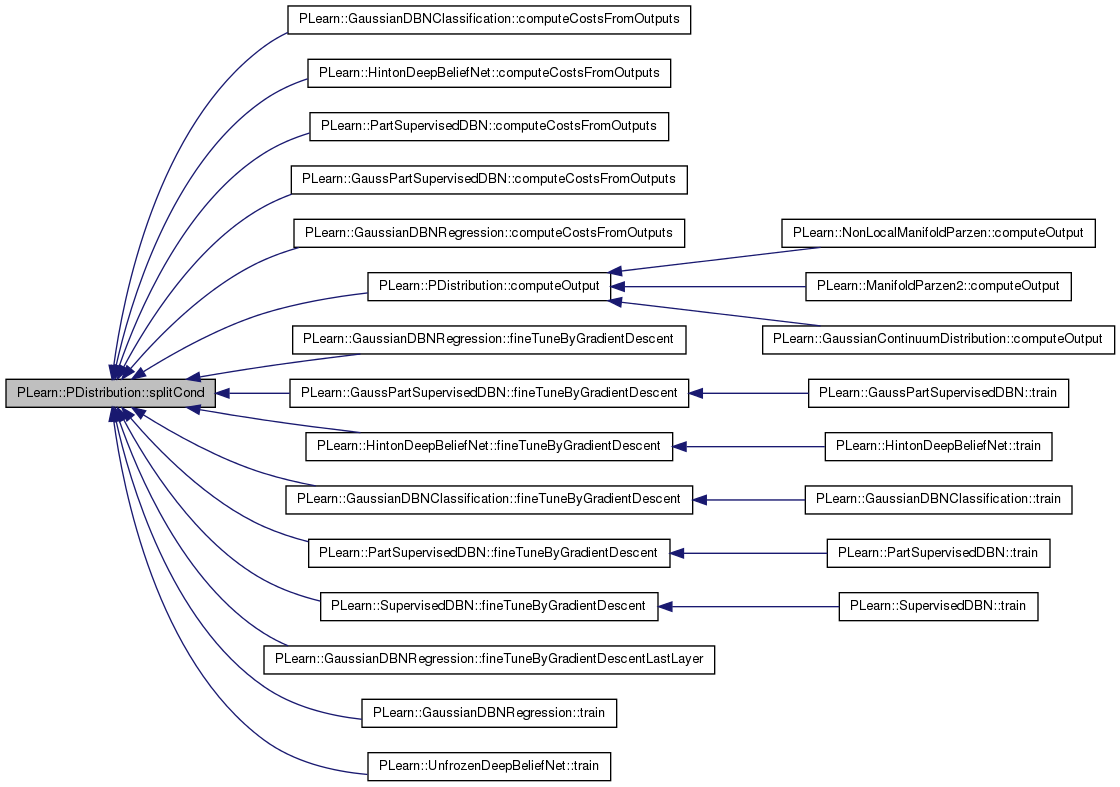
Return survival function: P(Y>y | x).
Reimplemented in PLearn::ConditionalDensityNet, PLearn::GaussMix, PLearn::HistogramDistribution, PLearn::KernelDensityEstimator, PLearn::MixtureDistribution, PLearn::NGramDistribution, PLearn::RBMDistribution, PLearn::SpiralDistribution, PLearn::UniformDistribution, PLearn::GaussianDBNClassification, PLearn::GaussianDBNRegression, PLearn::GaussPartSupervisedDBN, PLearn::HintonDeepBeliefNet, PLearn::PartSupervisedDBN, PLearn::SupervisedDBN, and PLearn::ManifoldKNNDistribution.
Definition at line 566 of file PDistribution.cc.
References PLERROR.
Referenced by computeOutput(), and PLearn::PConditionalDistribution::computeOutput().
{ PLERROR("survival_fn not implemented for this PDistribution"); return 0; }

| void PLearn::PDistribution::train | ( | ) | [virtual] |
The role of the train method is to bring the learner up to stage==nstages, updating the train_stats collector with training costs measured on-line in the process.
Implements PLearn::PLearner.
Reimplemented in PLearn::ConditionalDensityNet, PLearn::GaussianContinuumDistribution, PLearn::GaussianProcessRegressor, PLearn::LocallyMagnifiedDistribution, PLearn::NeighborhoodBoxVolumeDensityEstimator, PLearn::TransformationLearner, PLearn::GaussianDistribution, PLearn::GaussMix, PLearn::HistogramDistribution, PLearn::KernelDensityEstimator, PLearn::ManifoldParzen2, PLearn::MixtureDistribution, PLearn::NGramDistribution, PLearn::NonLocalManifoldParzen, PLearn::ParzenWindow, PLearn::RandomGaussMix, PLearn::RBMDistribution, PLearn::GaussianDBNClassification, PLearn::GaussianDBNRegression, PLearn::GaussPartSupervisedDBN, PLearn::HintonDeepBeliefNet, PLearn::PartSupervisedDBN, PLearn::SupervisedDBN, PLearn::UnfrozenDeepBeliefNet, PLearn::GaussianProcessRegressor, and PLearn::ManifoldKNNDistribution.
Definition at line 622 of file PDistribution.cc.
References PLERROR.
{ PLERROR("The train() method is not implemented for this PDistribution"); }
| void PLearn::PDistribution::unknownOutput | ( | char | def, |
| const Vec & | input, | ||
| Vec & | output, | ||
| int & | k | ||
| ) | const [protected, virtual] |
Called in computeOutput when an unknown character is found.
Reimplemented in PLearn::GaussMix.
Definition at line 628 of file PDistribution.cc.
References PLERROR.
Referenced by computeOutput(), and PLearn::GaussMix::unknownOutput().
{
// Default is to throw an error.
// TODO Can we find a better way to do this?
PLERROR("In PDistribution::unknownOutput - Unrecognized outputs_def "
"character: '%c'", def);
}

| void PLearn::PDistribution::variance | ( | Mat & | cov | ) | const [virtual] |
Reimplemented in PLearn::ConditionalDensityNet, PLearn::GaussMix, PLearn::HistogramDistribution, PLearn::KernelDensityEstimator, PLearn::MixtureDistribution, PLearn::NGramDistribution, PLearn::RBMDistribution, PLearn::SpiralDistribution, PLearn::UniformDistribution, PLearn::GaussianDBNClassification, PLearn::GaussianDBNRegression, PLearn::GaussPartSupervisedDBN, PLearn::HintonDeepBeliefNet, PLearn::PartSupervisedDBN, PLearn::SupervisedDBN, and PLearn::ManifoldKNNDistribution.
Definition at line 578 of file PDistribution.cc.
References PLERROR.
Referenced by computeOutput(), and PLearn::PConditionalDistribution::computeOutput().
{ PLERROR("variance not implemented for this PDistribution"); }

Reimplemented from PLearn::PLearner.
Reimplemented in PLearn::ConditionalDensityNet, PLearn::GaussianContinuumDistribution, PLearn::GaussianProcessRegressor, PLearn::PConditionalDistribution, PLearn::LocallyMagnifiedDistribution, PLearn::NeighborhoodBoxVolumeDensityEstimator, PLearn::TransformationLearner, PLearn::GaussianDistribution, PLearn::GaussMix, PLearn::HistogramDistribution, PLearn::KernelDensityEstimator, PLearn::ManifoldParzen2, PLearn::MixtureDistribution, PLearn::NGramDistribution, PLearn::NonLocalManifoldParzen, PLearn::ParzenWindow, PLearn::RandomGaussMix, PLearn::RBMDistribution, PLearn::SpiralDistribution, PLearn::UnconditionalDistribution, PLearn::UniformDistribution, PLearn::GaussianDBNClassification, PLearn::GaussianDBNRegression, PLearn::GaussPartSupervisedDBN, PLearn::HintonDeepBeliefNet, PLearn::PartSupervisedDBN, PLearn::SupervisedDBN, PLearn::UnfrozenDeepBeliefNet, and PLearn::ManifoldKNNDistribution.
Definition at line 182 of file PDistribution.h.
real PLearn::PDistribution::delta_curve [protected] |
The step when plotting the curve (upper case outputs_def).
Definition at line 114 of file PDistribution.h.
Referenced by build_(), and computeOutput().
Definition at line 141 of file PDistribution.h.
Referenced by PLearn::ConditionalDensityNet::build_(), build_(), computeOutput(), PLearn::PConditionalDistribution::computeOutput(), and declareOptions().
Definition at line 142 of file PDistribution.h.
Referenced by PLearn::ConditionalDensityNet::build_(), build_(), computeOutput(), PLearn::PConditionalDistribution::computeOutput(), declareOptions(), and outputsize().
int PLearn::PDistribution::n_predicted [mutable, protected] |
Definition at line 133 of file PDistribution.h.
Referenced by PLearn::SupervisedDBN::build_layers(), PLearn::PartSupervisedDBN::build_layers(), PLearn::GaussPartSupervisedDBN::build_layers(), PLearn::GaussianDBNRegression::build_layers(), PLearn::GaussianDBNClassification::build_layers(), PLearn::HintonDeepBeliefNet::build_layers(), PLearn::PartSupervisedDBN::build_params(), PLearn::HintonDeepBeliefNet::build_params(), PLearn::GaussianDBNRegression::build_params(), PLearn::GaussPartSupervisedDBN::build_params(), PLearn::GaussianDBNClassification::build_params(), PLearn::PartSupervisedDBN::build_regressors(), PLearn::GaussPartSupervisedDBN::build_regressors(), PLearn::SupervisedDBN::build_regressors(), PLearn::GaussianDBNClassification::computeCostsFromOutputs(), PLearn::HintonDeepBeliefNet::computeCostsFromOutputs(), PLearn::PartSupervisedDBN::computeCostsFromOutputs(), PLearn::GaussPartSupervisedDBN::computeCostsFromOutputs(), PLearn::GaussMix::computeLogLikelihood(), computeOutput(), declareOptions(), PLearn::PartSupervisedDBN::density(), PLearn::GaussianDBNRegression::density(), PLearn::SupervisedDBN::density(), PLearn::HintonDeepBeliefNet::density(), PLearn::GaussPartSupervisedDBN::density(), PLearn::GaussianDBNClassification::density(), PLearn::GaussMix::expectation(), PLearn::GaussPartSupervisedDBN::fineTuneByGradientDescent(), PLearn::HintonDeepBeliefNet::fineTuneByGradientDescent(), PLearn::PartSupervisedDBN::fineTuneByGradientDescent(), PLearn::SupervisedDBN::fineTuneByGradientDescent(), forget(), PLearn::RBMDistribution::forget(), PLearn::GaussMix::generateFromGaussian(), generateJoint(), generateN(), PLearn::SupervisedDBN::greedyStep(), PLearn::PartSupervisedDBN::greedyStep(), PLearn::GaussPartSupervisedDBN::greedyStep(), PLearn::GaussPartSupervisedDBN::jointGreedyStep(), PLearn::GaussianDBNClassification::jointGreedyStep(), PLearn::HintonDeepBeliefNet::jointGreedyStep(), PLearn::PartSupervisedDBN::jointGreedyStep(), outputsize(), PLearn::GaussMix::resizeDataBeforeUsing(), PLearn::GaussMix::setPredictor(), PLearn::GaussianDBNRegression::setPredictorPredictedSizes(), PLearn::GaussianDBNClassification::setPredictorPredictedSizes(), PLearn::HintonDeepBeliefNet::setPredictorPredictedSizes(), PLearn::GaussPartSupervisedDBN::setPredictorPredictedSizes(), PLearn::PartSupervisedDBN::setPredictorPredictedSizes(), PLearn::SupervisedDBN::setPredictorPredictedSizes(), setPredictorPredictedSizes(), PLearn::GaussMix::setPredictorPredictedSizes_const(), splitCond(), and PLearn::GaussianDBNRegression::train().
int PLearn::PDistribution::n_predictor [mutable, protected] |
Learnt sizes of the 'predictor' and 'predicted' sizes.
These are the options to use in PDistribution subclasses code. They always verify: n_predictor + n_predicted == inputsize()
Definition at line 132 of file PDistribution.h.
Referenced by PLearn::GaussMix::addToCovariance(), PLearn::PartSupervisedDBN::build_layers(), PLearn::SupervisedDBN::build_layers(), PLearn::GaussPartSupervisedDBN::build_layers(), PLearn::GaussianDBNRegression::build_layers(), PLearn::GaussianDBNClassification::build_layers(), PLearn::HintonDeepBeliefNet::build_layers(), PLearn::GaussMix::computeLogLikelihood(), declareOptions(), PLearn::RandomGaussMix::declareOptions(), PLearn::UnconditionalDistribution::declareOptions(), PLearn::GaussMix::expectation(), PLearn::SupervisedDBN::fineTuneByGradientDescent(), forget(), PLearn::GaussMix::generateFromGaussian(), generateJoint(), PLearn::SupervisedDBN::greedyStep(), PLearn::PartSupervisedDBN::greedyStep(), PLearn::GaussPartSupervisedDBN::greedyStep(), PLearn::GaussPartSupervisedDBN::jointGreedyStep(), PLearn::GaussianDBNClassification::jointGreedyStep(), PLearn::HintonDeepBeliefNet::jointGreedyStep(), PLearn::PartSupervisedDBN::jointGreedyStep(), PLearn::GaussMix::log_density(), PLearn::GaussMix::replaceGaussian(), PLearn::GaussMix::resizeDataBeforeUsing(), setPredictor(), PLearn::GaussMix::setPredictor(), PLearn::GaussianDBNClassification::setPredictorPredictedSizes(), PLearn::GaussianDBNRegression::setPredictorPredictedSizes(), PLearn::HintonDeepBeliefNet::setPredictorPredictedSizes(), PLearn::GaussPartSupervisedDBN::setPredictorPredictedSizes(), PLearn::PartSupervisedDBN::setPredictorPredictedSizes(), PLearn::SupervisedDBN::setPredictorPredictedSizes(), setPredictorPredictedSizes(), PLearn::GaussMix::setPredictorPredictedSizes_const(), splitCond(), PLearn::HintonDeepBeliefNet::train(), PLearn::GaussianDBNRegression::train(), and PLearn::GaussianDBNClassification::train().
Definition at line 143 of file PDistribution.h.
Referenced by PLearn::ConditionalDensityNet::build_(), PLearn::PConditionalDistribution::build_(), PLearn::GaussianDBNClassification::computeCostsFromOutputs(), PLearn::GaussianProcessRegressor::computeCostsFromOutputs(), PLearn::HintonDeepBeliefNet::computeCostsFromOutputs(), PLearn::PartSupervisedDBN::computeCostsFromOutputs(), PLearn::GaussPartSupervisedDBN::computeCostsFromOutputs(), PLearn::SupervisedDBN::computeCostsFromOutputs(), PLearn::GaussianDBNRegression::computeCostsFromOutputs(), computeCostsFromOutputs(), PLearn::GaussianProcessRegressor::computeOutput(), computeOutput(), PLearn::PConditionalDistribution::computeOutput(), PLearn::GaussianContinuumDistribution::computeOutput(), PLearn::HistogramDistribution::computeOutput(), PLearn::NonLocalManifoldParzen::computeOutput(), PLearn::ManifoldParzen2::computeOutput(), declareOptions(), PLearn::UnconditionalDistribution::declareOptions(), PLearn::GaussianDBNClassification::getTestCostNames(), PLearn::GaussPartSupervisedDBN::getTestCostNames(), PLearn::HintonDeepBeliefNet::getTestCostNames(), PLearn::SupervisedDBN::getTestCostNames(), PLearn::PartSupervisedDBN::getTestCostNames(), PLearn::GaussianDBNRegression::getTestCostNames(), PLearn::GaussMix::outputsize(), PLearn::NonLocalManifoldParzen::outputsize(), PLearn::ManifoldParzen2::outputsize(), PLearn::GaussianContinuumDistribution::outputsize(), PLearn::GaussianProcessRegressor::outputsize(), and outputsize().
Vec PLearn::PDistribution::predicted_part [mutable, protected] |
Used to store the y part in p(y|x).
Definition at line 117 of file PDistribution.h.
Referenced by PLearn::GaussianDBNClassification::computeCostsFromOutputs(), PLearn::HintonDeepBeliefNet::computeCostsFromOutputs(), PLearn::PartSupervisedDBN::computeCostsFromOutputs(), PLearn::GaussPartSupervisedDBN::computeCostsFromOutputs(), PLearn::GaussianDBNRegression::computeCostsFromOutputs(), computeOutput(), PLearn::SupervisedDBN::expectation(), PLearn::GaussianDBNRegression::fineTuneByGradientDescent(), PLearn::GaussPartSupervisedDBN::fineTuneByGradientDescent(), PLearn::HintonDeepBeliefNet::fineTuneByGradientDescent(), PLearn::GaussianDBNClassification::fineTuneByGradientDescent(), PLearn::PartSupervisedDBN::fineTuneByGradientDescent(), PLearn::GaussianDBNRegression::fineTuneByGradientDescentLastLayer(), makeDeepCopyFromShallowCopy(), setPredictorPredictedSizes(), splitCond(), PLearn::UnfrozenDeepBeliefNet::train(), and PLearn::GaussMix::unknownOutput().
int PLearn::PDistribution::predicted_size [protected] |
Definition at line 127 of file PDistribution.h.
Referenced by PLearn::GaussianDistribution::build_(), PLearn::GaussMix::build_(), PLearn::SupervisedDBN::build_(), PLearn::RBMDistribution::build_(), PLearn::SpiralDistribution::build_(), build_(), PLearn::SupervisedDBN::build_layers(), PLearn::SupervisedDBN::build_regressors(), PLearn::MixtureDistribution::declareOptions(), declareOptions(), PLearn::RandomGaussMix::declareOptions(), PLearn::UnconditionalDistribution::declareOptions(), PLearn::NGramDistribution::declareOptions(), PLearn::GaussianDBNRegression::expectation(), PLearn::GaussPartSupervisedDBN::expectation(), PLearn::PartSupervisedDBN::expectation(), PLearn::GaussianDBNClassification::expectation(), PLearn::HintonDeepBeliefNet::expectation(), PLearn::SupervisedDBN::expectation(), PLearn::GaussMix::missingExpectation(), PLearn::NGramDistribution::NGramDistribution(), PLearn::SupervisedDBN::setPredictorPredictedSizes(), setPredictorPredictedSizes(), and PLearn::GaussMix::train().
Vec PLearn::PDistribution::predictor_part [mutable, protected] |
Used to store the x part in p(y|x).
Definition at line 116 of file PDistribution.h.
Referenced by PLearn::GaussMix::build_(), build_(), PLearn::MixtureDistribution::declareOptions(), declareOptions(), PLearn::RandomGaussMix::declareOptions(), PLearn::UnconditionalDistribution::declareOptions(), PLearn::NGramDistribution::density(), PLearn::GaussianDBNRegression::expectation(), PLearn::GaussPartSupervisedDBN::expectation(), PLearn::PartSupervisedDBN::expectation(), PLearn::GaussianDBNClassification::expectation(), PLearn::HintonDeepBeliefNet::expectation(), PLearn::SupervisedDBN::expectation(), makeDeepCopyFromShallowCopy(), setPredictor(), PLearn::GaussMix::setPredictor(), setPredictorPredictedSizes(), and PLearn::UnfrozenDeepBeliefNet::train().
int PLearn::PDistribution::predictor_size [protected] |
User-provided sizes of the 'predictor' and 'predicted' sizes.
Since they may be equal to '-1', subclasses should generally only use the learnt options 'n_predictor' and 'n_predicted' below.
Definition at line 126 of file PDistribution.h.
Referenced by PLearn::NGramDistribution::build(), PLearn::GaussMix::build_(), build_(), PLearn::MixtureDistribution::declareOptions(), declareOptions(), PLearn::RandomGaussMix::declareOptions(), PLearn::UnconditionalDistribution::declareOptions(), PLearn::NGramDistribution::declareOptions(), PLearn::GaussMix::missingExpectation(), PLearn::NGramDistribution::NGramDistribution(), setPredictorPredictedSizes(), and PLearn::GaussMix::train().
Mat PLearn::PDistribution::store_cov [mutable, protected] |
Definition at line 109 of file PDistribution.h.
Referenced by computeOutput(), and makeDeepCopyFromShallowCopy().
Vec PLearn::PDistribution::store_expect [mutable, protected] |
Global storage to save memory allocations.
Definition at line 108 of file PDistribution.h.
Referenced by computeOutput(), PLearn::PartSupervisedDBN::density(), PLearn::GaussianDBNRegression::density(), PLearn::SupervisedDBN::density(), PLearn::HintonDeepBeliefNet::density(), PLearn::GaussPartSupervisedDBN::density(), PLearn::GaussianDBNClassification::density(), and makeDeepCopyFromShallowCopy().
Vec PLearn::PDistribution::store_result [mutable, protected] |
Definition at line 108 of file PDistribution.h.
Referenced by computeOutput(), and makeDeepCopyFromShallowCopy().
Definition at line 141 of file PDistribution.h.
Referenced by PLearn::ConditionalDensityNet::build_(), build_(), PLearn::PConditionalDistribution::computeOutput(), and declareOptions().
 1.7.4
1.7.4